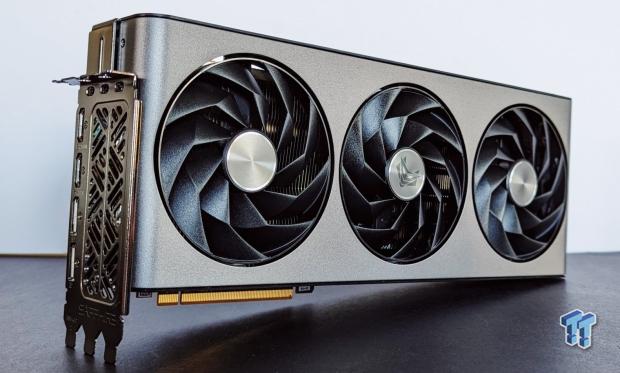
The Bottom Line
Pros
- + Excellent 1440p performance
- + Stylish and robust full metal build
- + Competitively priced and great value
- + It gives the GeForce RTX 4070 a run for its money
- + A free copy of Starfield helps sweeten the deal
Cons
- - Ray-tracing performance is still a step behind the competition
- - Sharp performance drop-off when gaming in 4K
- - AMD FSR 2 not on par with NVIDIA DLSS at 1440p
Should you buy it?
AvoidConsiderShortlistBuyIntroduction
AMD's Radeon RX 7800 XT is an interesting GPU in that it's an excellent 1440p performer with some key benefits over its predecessor thanks to the switch to RDNA 3. And yet, on average, it doesn't offer the sort of major generational uplift in performance we're used to seeing -performance, for the most part, is on par with the Radeon RX 6800 XT.
A low price point is one of the card's key features, at least in helping to establish why it has been so well received (as detailed in our review of AMD's reference Radeon RX 7800 XT). An MSRP of USD 499 sits well below the Radeon RX 6800 XT's launch price of USD 649. Plus, with a decent performance uplift compared to the Radeon RX 7700 XT that launched simultaneously, you could easily argue that it's the best value option.
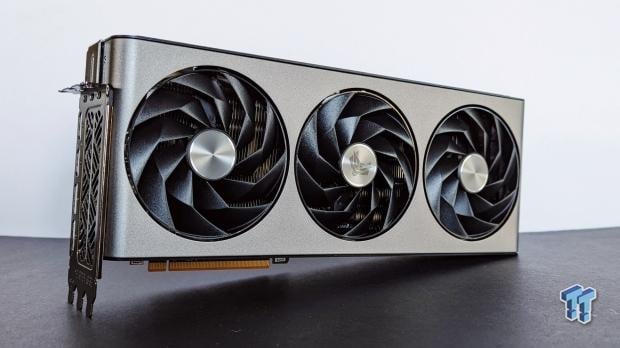
You might call it an aggressive move by AMD, offering some serious (and sorely needed) competition - especially against the more expensive GeForce RTX 4070. Ultimately, it highlights a genuine need for value alongside performance at a time when PC and hardware prices across the board are rising. A more efficient and affordable generational update can be as exciting as one that delivers greater performance while pushing the price. The point is that the Radeon RX 7800 XT is an attractive GPU worth considering.
With that in mind, the new Sapphire NITRO+ Radeon RX 7800 XT represents a more premium, overclocked variant that also delivers when it comes to looks and thermal performance. It features one of the most visually striking and elegant designs for a GPU in 2023, with a brushed metal 'Cold Rolled Steel Frame' that wraps around the entire card and a large ARGB lighting strip that will make it the centerpiece of any PC case. Let's dig in.

The RDNA 3 Generation
"The world's first chiplet gaming GPU" is how AMD described its new RDNA 3-based GPUs when it lifted the lid on the new Radeon RX 7000 Series. In layperson's terms, the GPU chip isn't just one big square or die anymore, with billions of transistors all arranged in a single layout. Like with its Ryzen CPU range, which embraced chiplet design to great effect (look at how Ryzen has grown in popularity over the years), bringing this design philosophy into the GPU space felt like the natural evolution for AMD's Radeon brand.
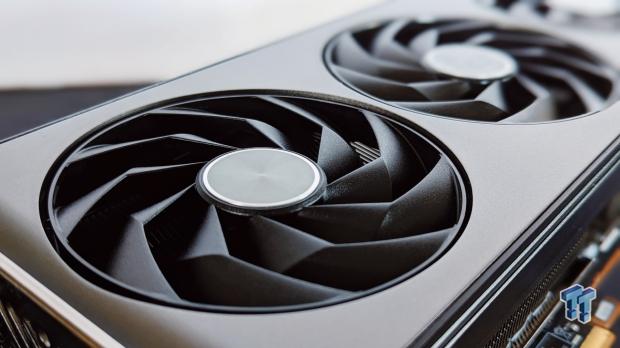
For RDNA 3, what was once a single Graphics Compute Die (GCD) has now split into a GCD plus a Memory Cache Die (MCD). The GCD still makes up most of the hardware grunt and uses the newer 5nm process technology - a step up from RDNA 2's 7nm process. Interestingly, the MCD uses 6nm process technology, which allows AMD to keep costs down as the complexity and cost of manufacturing high-end tech continue to rise.
And to mitigate any performance impact that could arise from going the chiplet route, AMD has also managed to include the "fastest chiplet interconnect in the world," with speeds of 5.3 TB/s. That said, the Radeon RX 7600 entry-level models using the 'Navi 33' GPU follow a more traditional single-chip setup using 6nm process technology to help keep costs down. But with the same RDNA 3 architecture.
AMD's groundbreaking chiplet design can be found in the 'Navi 32' and 'Navi 31' GPUs - Radeon RX 7700 XT, 7800 XT, 7900 XT, and 7900 XTX. AMD's RDNA 3 architecture also features second-generation AMD Infinity Cache, another CPU-like feature designed to boost performance in 1440p and 4K gaming - a "bandwidth amplifier" that sits alongside the GDDR6 memory interface. It helps alleviate the need for more expensive and power-hungry memory buses and is one of those forward-thinking designs we love seeing.
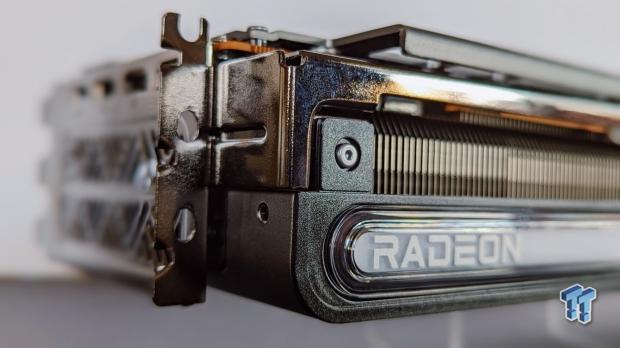
RDNA 3 also represents a significant leap forward for AMD regarding ray-tracing and AI accelerators. RDNA 3 GPUs feature the second generation of dedicated RT hardware and new hardware-based AI acceleration. Real-time ray tracing is hardware intensive; this is one area many were looking for AMD to improve compared to RDNA 2. Which, admittedly, was the company's first attempt at hardware-based ray tracing.
RDNA 3 GPUs are the first graphics cards supporting the new DisplayPort 2.1 spec. The latest DisplayPort interface supports up to 4K 480Hz and even 8K 165Hz, which makes it more of a future-proofing measure than something applicable today. But the real benefit comes with 12-bit HDR support and full Rec2020 coverage for improved color accuracy and detail.
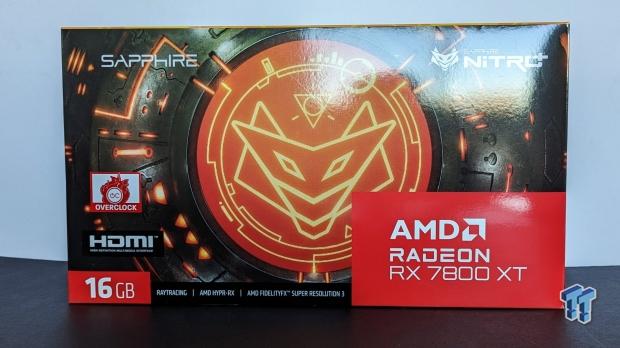
RDNA 3 also introduces hardware-based AV1 encoding to step up its video game for content creators, which means better quality video using the same bitrate. Very cool. For gamers, the introduction of AMD FSR 2 rendering is fully supported here and helps improve performance in intensive games. FSR 2 support might not be as widespread as NVIDIA DLSS, but its addition to games like Cyberpunk 2077 and Starfield is a great sign. Plus, as the tech is fully supported on Xbox Series X|S and PlayStation 5 (with both consoles using AMD graphics hardware), in-game FSR support should grow as time passes.
AMD's DLSS 3-like FSR 3 frame generation technology called 'AMD Fluid Motion Frames' will debut soon. FSR 3, like FSR 2, will be platform agnostic in that it will work across AMD, NVIDIA, and Intel hardware - but on RDNA 3 and Radeon GPUs, it will take advantage of the new Anti-Lag+ to reduce latency (something NVIDIA alleviates by pairing DLSS 3 with its Reflex latency reduction technology). Ultimately, RDNA 3 is an impressive leap forward for AMD, bringing massive changes to the underlying hardware while delivering a sizable performance leap over the previous RDNA 2 generation.
Specs and Test System
Specifications
Here, we can see how the specs and hardware stack up for the AMD Radeon RX 7700 XT and 7800 XT compared to the previous generation's AMD Radeon RX 6700 XT and 6800 XT.
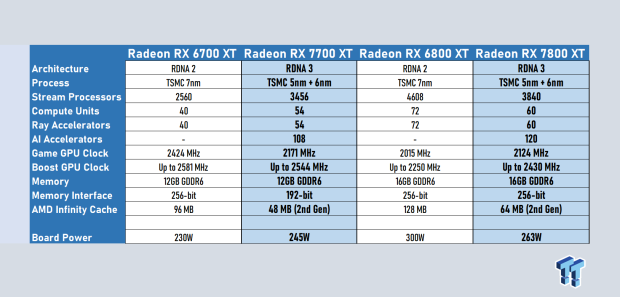
As the generational successor to the Radeon RX 6800 XT, the new Radeon RX 7800 XT specs present a different story than what we're used to. Looking at the pure numbers, you might think it's a step down in terms of what it offers - as you're looking at a 16.7% reduction in Stream Processor, Compute Unit, and Ray Accelerator counts.
Throw in 64MB of AMD Infinity cache on the Radeon RX 7800 XT compared to the 128MB on the Radeon RX 6800 XT, and you've got specs where the only real positive movement comes with the Boost Clock Speed. The Sapphire NITRO+ Radeon RX 7800 XT delivers a noticeable bump to 2565 MHz compared to AMD's reference spec of 2430 MHz - which is nice.
Of course, going from RDNA 2 to RDNA 3 means there are significant architectural changes, in addition to AMD's switch to a chiplet design for the Radeon RX 7800 XT. RDNA 3 brings noticeable improvements to AMD's hardware-accelerated ray-tracing performance and adds creator-friendly AV1 encoding plus support for DisplayPort 2.1. The AMD Infinity Cache is a next-gen version, so it's not a like-for-like comparison.
The overall power rating has dropped, too. On that front, the Sapphire NITRO+ Radeon RX 7800 XT takes the 263W total board power rating up to 288W, which is close to the Radeon RX 6800 XT's 300W power rating. However, based on what we've seen with NVIDIA's new Ada-powered GeForce RTX 40 Series generation, the efficiency gains for AMD and RDNA 3 are disappointing.
The good news is that the Radeon RX 7800 XT retains its predecessor's 16GB of GDDR6 VRAM on a similar 256-bit interface, making it one of the most powerful and affordable 16GB GPUs in 2023. VRAM capacity has been a hot topic in recent months, and having 16GB of VRAM helps future-proof the Sapphire NITRO+ Radeon RX 7800 XT for 1440p and even 4K gaming.
- GPU: AMD Radeon RX 7800 XT
- Model: Sapphire NITRO+ Radeon RX 7800 XT 16GB
- Interface: PCI Express 4.0
- Stream Processors: 3840
- Compute Units/Ray Accelerators/AI Accelerators: 60/60/120
- Clock Speeds: Boost Clock: Up to 2565 MHz, Game Clock: 2254 MHz
- Memory: 16GB GDDR6
- Memory Speed: 19.5 Gbps
- Memory Interface: 256-bit
- Display Connections: 2 x HDMI 2.1, 2 x DisplayPort 2.1
- Power Connectors: 2 x 8-pin
- Total Board Power: 288W
- What's in the Box: Sapphire NITRO+ Radeon RX 7800 XT 16GB, Graphics Card Supporter, ARGB Extension Cable
Kosta's Test System
- Motherboard: MSI MPG X670E Carbon Wi-Fi
- CPU: AMD Ryzen 9 7900X
- Cooler: Corsair iCUE H100i RGB PRO XT Liquid CPU Cooler
- RAM: 64GB (2x32GB) Corsair DOMINATOR PLATINUM RGB DDR5 DRAM 5200MHz
- SSD: Sabrent Rocket 4 Plus-G M.2 PCIe Gen 4 SSD 4TB, Sabrent Rocket 4 Plus M.2 PCIe Gen 4 SSD 8TB
- Power Supply: Thermaltake Toughpower GF1 850W
- Case: Thermaltake Core P3 Tempered Glass Snow
- OS: Microsoft Windows 11 Pro 64-bit
Physical Design and Cooling
As mentioned in the introduction, the new Sapphire NITRO+ Radeon RX 7800 XT is one of the best-looking GPUs in 2023. Of course, looks are subjective, and the fully wrapped brushed metal shroud (which Sapphire is calling the card's Cold Rolled Steel Frame) might be too minimal for some. It's stylish, and the ARGB light strip on the top adds a lot to the overall look to help personalize and make it stand out in any PC case as a showpiece.
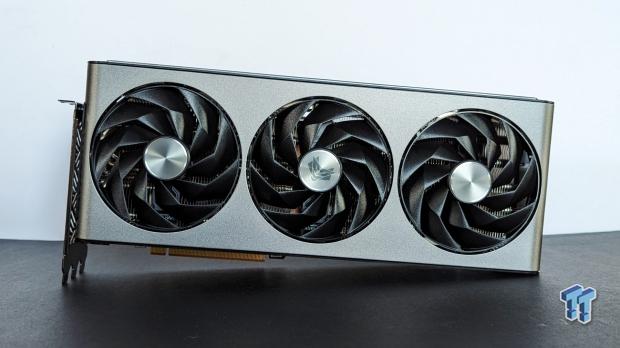
But this is just the aesthetic side of the Sapphire NITRO+ Radeon RX 7800 XT, with dimensions of 320 x 134.85 x 61.57 mm and solid weight; it's sturdy and built like a tank. It features a full metal backplate, copper PCB, dedicated VRM cooling, Sapphire's 'Angular Velocity Fan Blade' design, 14-phase power, and composite heat pipes built with an eye towards cooling and optimized thermal performance.
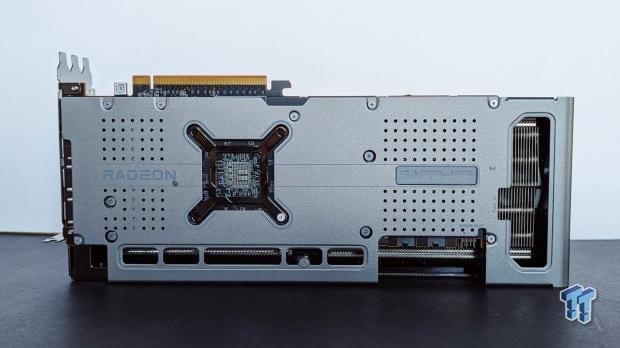
This extends to the 'Assisting System Fan Control' feature, where system fans can connect directly to the GPU and sync with Sapphire's TriXX software, so the GPU's fans and system fans increase simultaneously when under load. For a card that comes overclocked and can be pushed even further, this is a very cool option to have. The Sapphire NITRO+ Radeon RX 7800 XT also sports an ARGB connection to syn motherboard and system lighting and a dedicated Dual BIOS that can further be optimized and accessed with Sapphire's TriXX software.
Another feature of the Sapphire NITRO+ Radeon RX 7800 XT physical design worth celebrating is that the fans are removable for cleaning and easy replacement - with Sapphire offering replacement fans upon request.
Benchmarks - 15 Game Averages
The Games and Tests
In 2023, PC gaming is a complicated and varied space, from indie games to major blockbuster releases and titles that push hardware and technology to their limit with the adoption of effects like real-time ray-tracing.
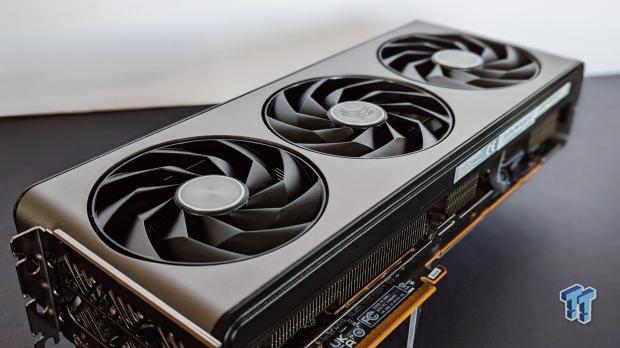
This is all a way of saying that the 15 in-game benchmarks we've chosen (run at 1080p, 1440p, and 4K) represent a wide range of styles, not only in terms of genres, like first-person shooters and racing games but also in the API technology (DirectX 11, 12) and cutting-edge features like ray tracing and upscaling technology.
Results include DLSS and FSR 2, where possible, as both technologies are the sorts of things, especially in 1440p and 4K, which you'd turn on. Six of the 15 game benchmarks also feature ray tracing. Also, each title is set to ultra-equivalent quality settings to push GPU hardware and minimize CPU bottlenecks at higher resolutions.
Also, it's just fun to max out a game's visual settings and see the results. Here's the breakdown of games, graphics settings, and what's being tested.
- Assassin's Creed Valhalla: Ultra High-quality settings, with the in-game benchmark tool used.
- Borderlands 3: Ultra quality settings, with the in-game benchmark tool used.
- Call of Duty: Modern Warfare II: Ultra quality setting, in-game multiplayer benchmark tool used. AMD FSR 2 and NVIDIA DLSS results are included.
- Cyberpunk 2077: Ultra quality setting, in-game benchmark tool used. AMD FSR 2 and NVIDIA DLSS results are included.
- Cyberpunk 2077 (RT): Ray tracing Ultra quality setting, in-game benchmark tool used. AMD FSR 2 and NVIDIA DLSS results are included.
- DOOM Eternal (RT): Ultra Nightmare quality setting with ray-tracing enabled, the opening of Mars Core campaign level used to benchmark. NVIDIA DLSS results included.
- F1 22 (RT): Ultra High-quality setting with ray tracing, one lap of the Bahrain track benchmarked. AMD FSR 2 and NVIDIA DLSS results are included.
- Forza Horizon 5 (RT): Extreme quality setting with ray tracing enabled, in-game benchmark tool used. AMD FSR 2 and NVIDIA DLSS results are included.
- Hitman (RT): Ultra-quality settings with ray-tracing, Dubai scene benchmarked. AMD FSR 2 and NVIDIA DLSS results are included.
- Horizon Zero Dawn: Ultimate quality setting, in-game benchmark used.
- Marvel's Guardians of the Galaxy (RT): Ultra quality setting with ray tracing enabled, the in-game benchmark tool used. NVIDIA DLSS results included.
- Rainbow Six Extraction: Ultra quality settings and in-game benchmark tool used. NVIDIA DLSS results included.
- Red Dead Redemption 2: Maximum quality settings, with in-game benchmark tool used. AMD FSR 2 and NVIDIA DLSS results are included.
- The Division 2: Ultra quality settings with in-game benchmark tool used.
- Total War: Warhammer III: Ultra-quality settings with the in-game Battle Benchmark tool used.
15 Game Average FPS - 1080p Results
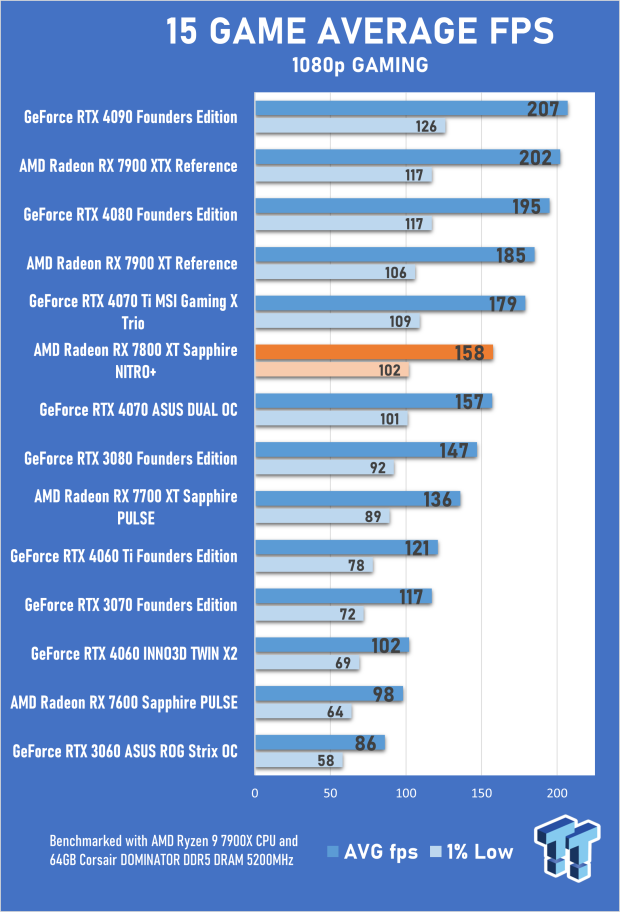
The nearest price competitor for the Radeon RX 7800 XT, from the GeForce RTX stable, is the GeForce RTX 4070 - so many comparisons from here on out regarding game performance will be between these two cards. Although I don't have a Radeon RX 6800 XT on hand to make a direct gen-on-gen comparison, the performance between the RTX 4070, the RTX 3080, and the 6800 XT is all within the same range (outside of ray-tracing) on average.
Across our 15-game benchmark suite, looking at 1080p gaming, the Sapphire NITRO+ Radeon RX 7800 XT performs roughly identical to the GeForce RTX 4070 - on average. Compared to its RDNA 3 sibling, the Radeon RX 7700 XT, the Radeon RX 7800 XT is a sizable 16% faster for 1080p gaming. Of course, the story is more nuanced than this regarding the GeForce RTX 4070 versus the Radeon RX 7800 XT - and a great example to showcase this is Cyberpunk 2077.
Without RT enabled, the Sapphire NITRO+ Radeon RX 7800 XT is 19% faster than the RTX 4070, an impressive win. Turn on RT, though, using the game's Ultra preset without any upscaling, and the RTX 4070 is a sizable 29% faster. For the most part, the Sapphire NITRO+ Radeon RX 7800 XT performs slightly faster than the GeForce RTX 4070, with big wins in titles like Call of Duty, while falling behind when the reflections, shadows, and other effects are ray traced.
14 Game Average FPS - 1440p Results
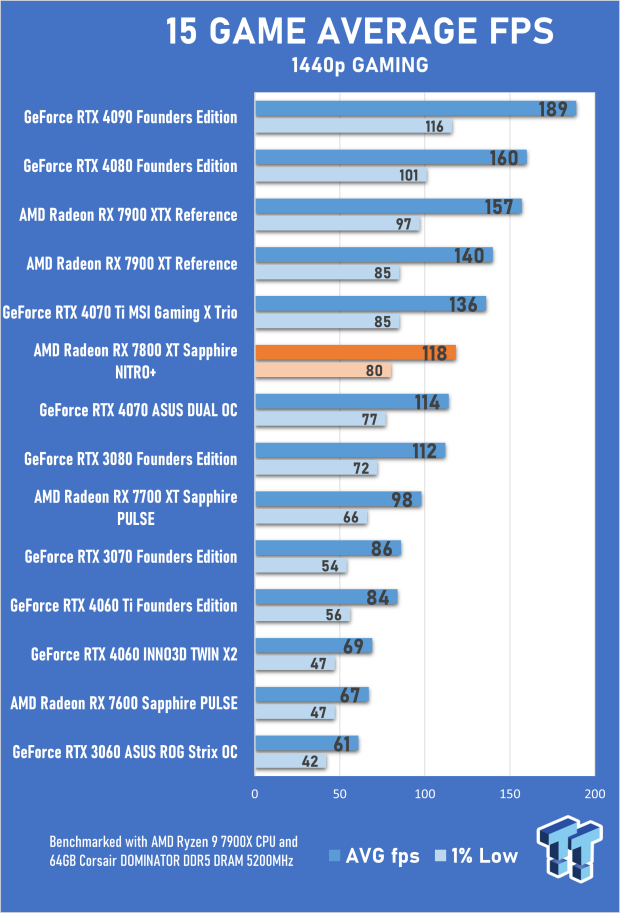
However, you wouldn't be looking at the Sapphire NITRO+ Radeon RX 7800 XT for 1080p gaming; its bread-and-butter is the 1440p sweet spot (the fastest-growing resolution when it comes to gaming monitors), and these results are probably the most important. The same performance between the Sapphire NITRO+ Radeon RX 7800 XT and the GeForce RTX 4070 extends to a 3.5% lead favoring the Radeon GPU. Here, the lead over the Radeon RX 7700 XT extends to 20%, too, which is worth keeping in mind because both cards are priced similarly.
As a premium model, the Sapphire NITRO+ Radeon RX 7800 XT's out-of-the-box overclock also means slightly better performance than AMD's reference design, which is always nice. With a 1% low average of 80fps and an overall 118 fps average - the Sapphire NITRO+ Radeon RX 7800 XT is cut out for high-end and fast 1440p gaming. As we saw with 1080p gaming performance, the RT chops aren't quite up to the competition but still fare well in games where ray-tracing is used sparingly, like F1 22 and Forza Horizon 5.
Again, on average, it's close, and this is reflected in most titles - outside of a few exceptions like Call of Duty: Modern Warfare II, where the Sapphire NITRO+ Radeon RX 7800 XT is 31% faster than the GeForce RTX 4070.
15 Game Average FPS - 4K Results
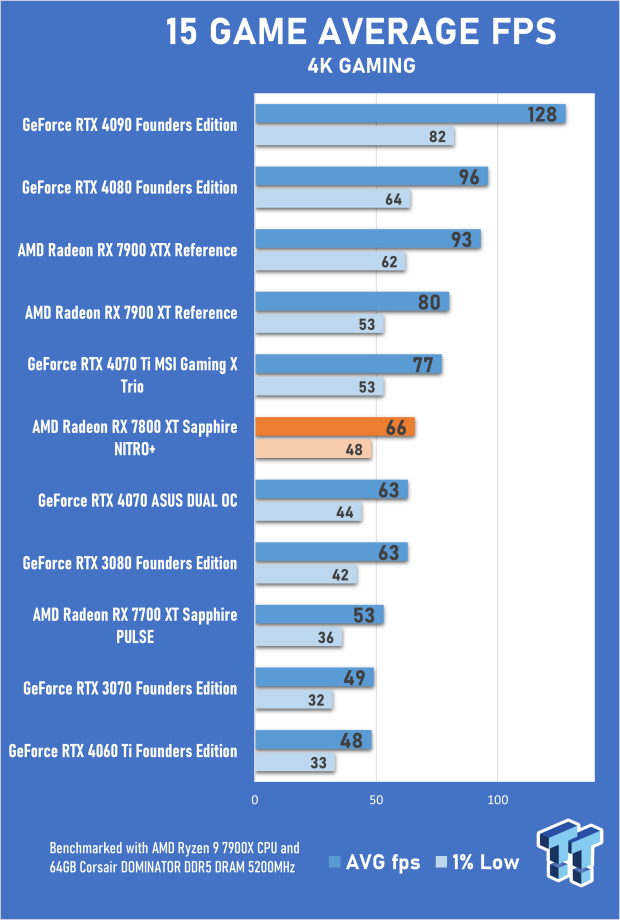
Some people are often surprised when a powerful GPU like the Radeon RX 7800 XT is marketed as a card for 1440p gaming - which boils down to forgetting that as visual fidelity increases, this doesn't mean that a 1440p card from 4 years ago is the same thing as a 1440p card from 2023. That little rant aside, the Sapphire NITRO+ Radeon RX 7800 XT can deliver decent 4K performance, especially with the aid of AMD's FSR 2 technology to boost performance when available.
There are limitations, and some detail settings might need to be lowered (or, in the case of ray-tracing, disabled entirely), but the overall 4K average of 66 fps is a testament to the card's UHD abilities. Though we're now at a point with PC gaming where 60fps is considered entry-level, triple-digit is the way to go.
Once again, this result is close to the GeForce RTX 4070, with the lead extending just a bit more to 4.8%. The lead over the Radeon RX 7700 XT also grew to 24.5%. Still, the performance drop-off when jumping from 1440p to 4K is huge - sitting at 44% - so this resolution is more of a play-and-see.
Benchmarks - 3DMark FireStrike
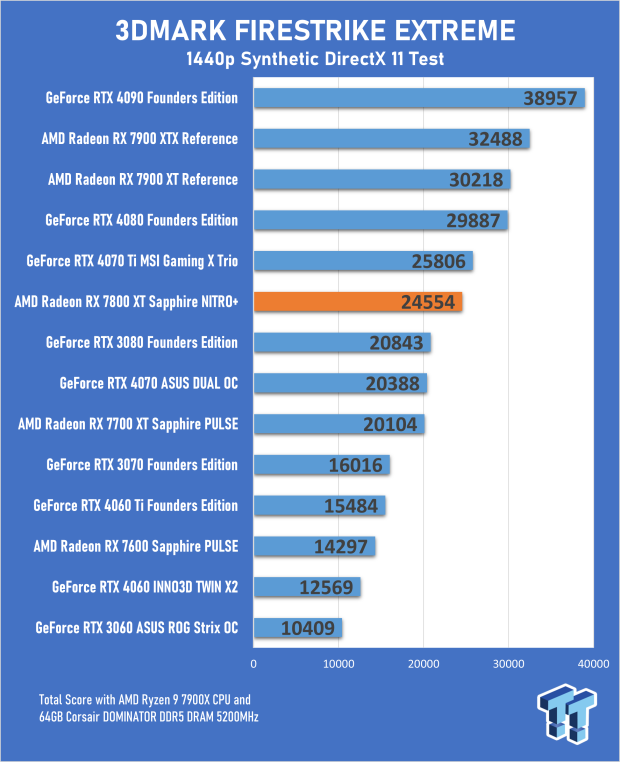
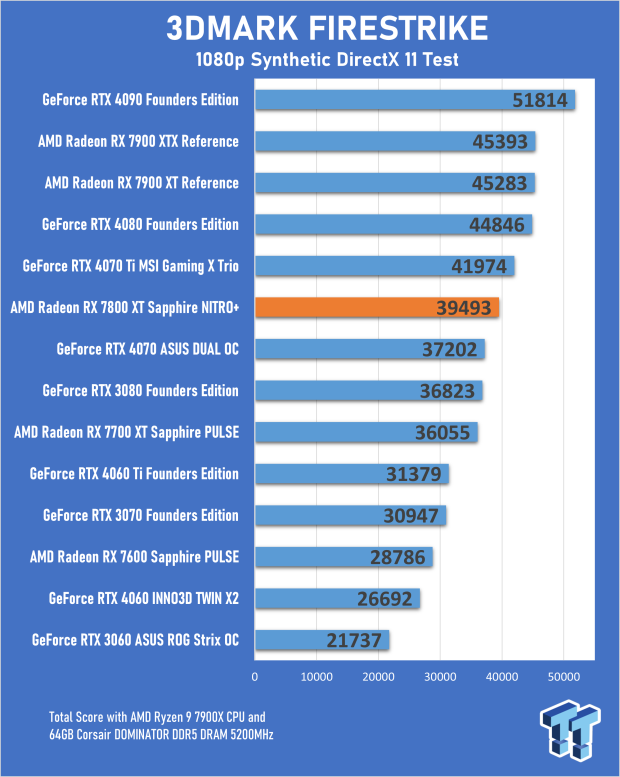
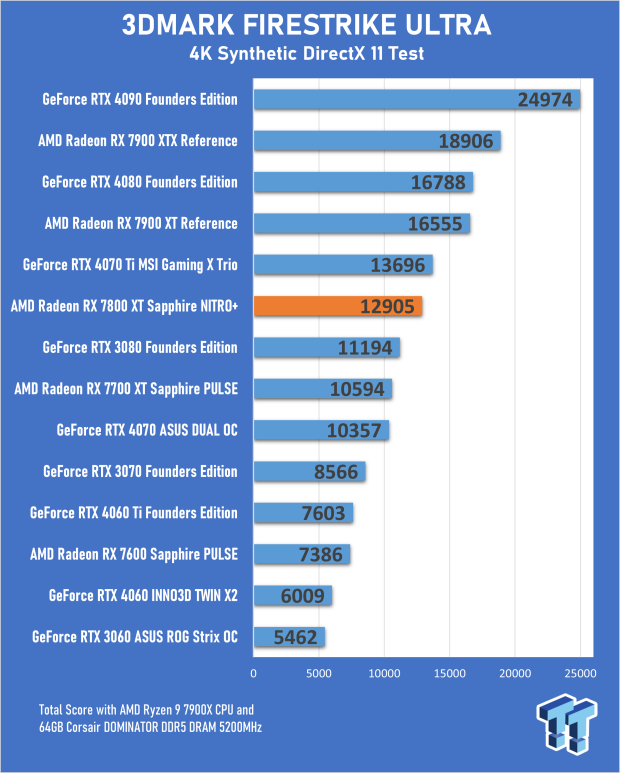
3DMark FireStrike is a DirectX 11 test that has been around for several years; it covers quite a large portion of games released over the past decade, so it's still a relevant benchmark. The three tests cover the main 16:9 resolutions - 1080p, 1440p, and 4K. The 1440p Extreme test is highlighted above because the Radeon RX 7800 XT is a GPU tailor-made for this resolution.
A synthetic benchmark, and it's worth keeping this in mind, the result sees the Sapphire NITRO+ Radeon RX 7800 XT deliver a score roughly 20% higher than the GeForce RTX 4070 and the Radeon RX 7700 XT. This isn't accurate or similar to our in-game results. Still, it's in line with results we've been seeing of late, where AMD and Radeon GPUs generally perform better in this 3DMark test than NVIDIA's GeForce RTX graphics cards.
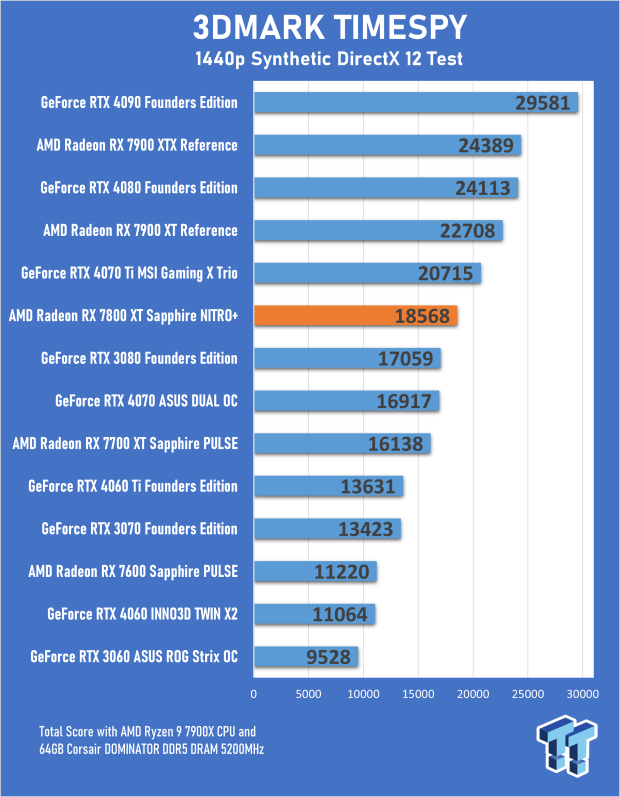
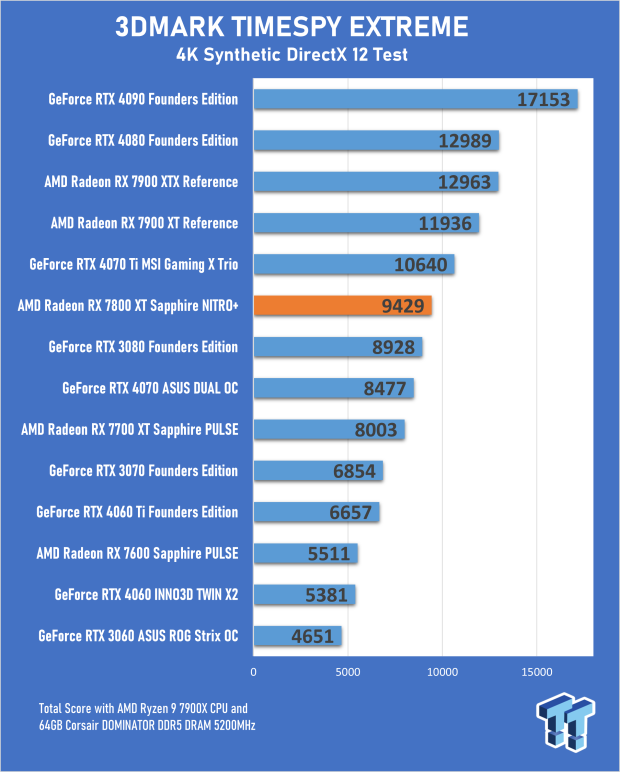
3DMark TimeSpy is a DirectX 12 synthetic benchmark and is more relevant to modern games as it represents the latest version of the API. Here, the results for the Sapphire NITRO+ Radeon RX 7800 XT across the 1440p and 4K benchmark do closer reflect what we've found when gaming - but it still skews in favor of RDNA 3 versus NVIDIA's latest architecture. However, the 1440p score that is 15% higher than the Radeon RX 7700 XT and 9.8% higher than the GeForce RTX 4070 is similar to what you will find in several games without ray-tracing enabled.
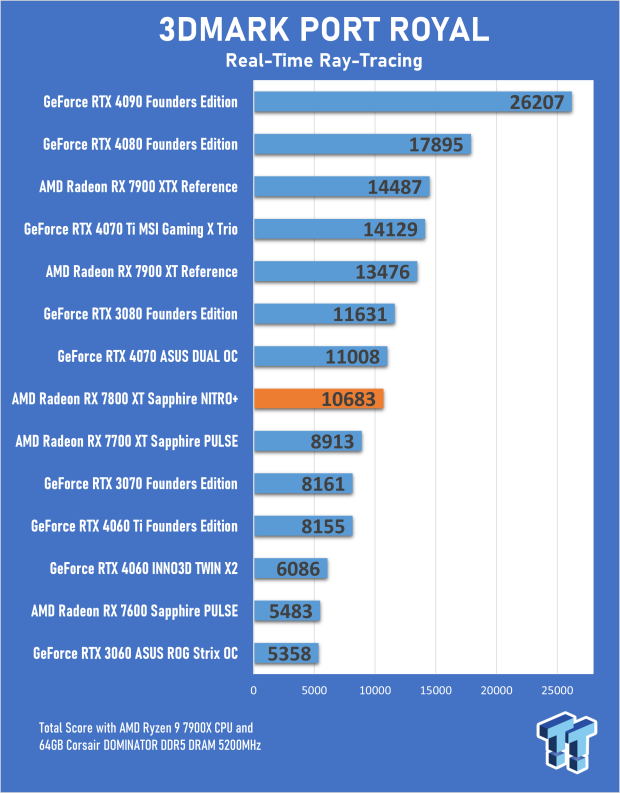
Speaking of ray tracing, you might think that the Sapphire NITRO+ Radeon RX 7800 XT would deliver a score and result several steps lower than the GeForce RTX 4070 and other NVIDIA cards when it comes to the 3DMark Port Royal benchmark. This isn't the case, and in fact, this test shows that AMD's ray-tracing hardware has come a long way, with the score here being very close to the RTX 4070.
And in many RT-enabled games, this holds; it's only when you crank up the effects in Cyberpunk 2077 and Hitman that you begin to see the Sapphire NITRO+ Radeon RX 7800 XT struggle a little bit. Especially when gaming in 1440p, AMD's FSR 2 image quality at this resolution is a noticeable step behind NVIDIA's DLSS. This also applies to FSR 2 versus DLSS at 1440p in non-ray-tracing games.
Benchmarks - 1080p Gaming
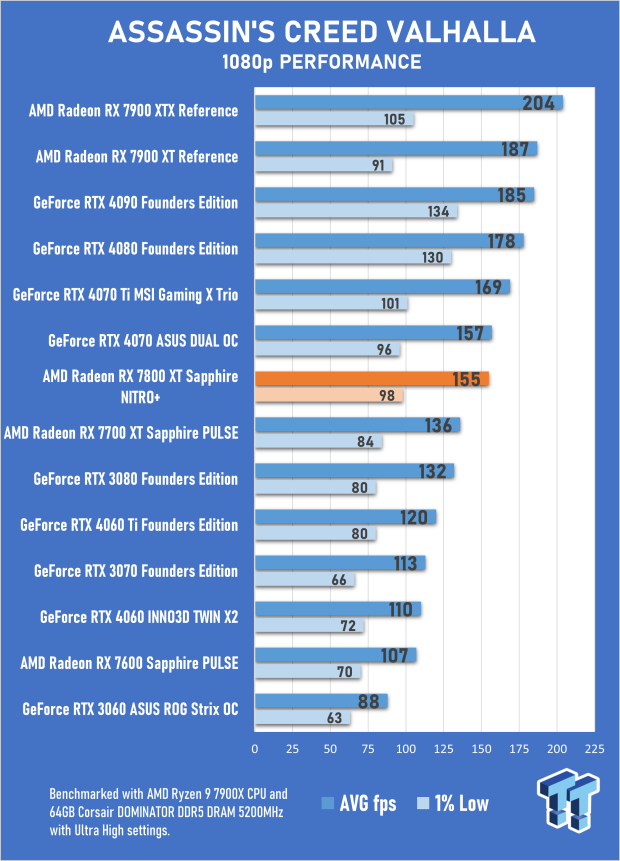
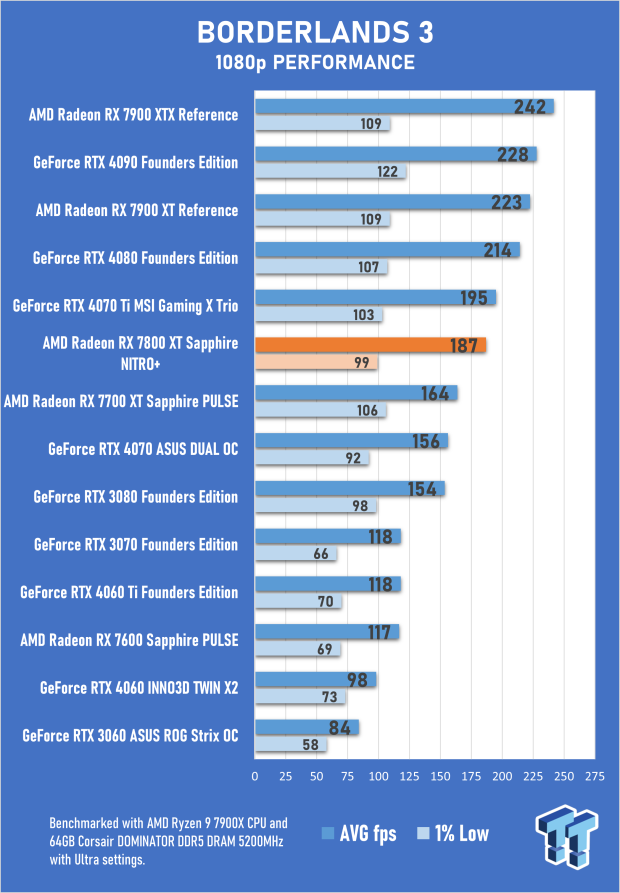
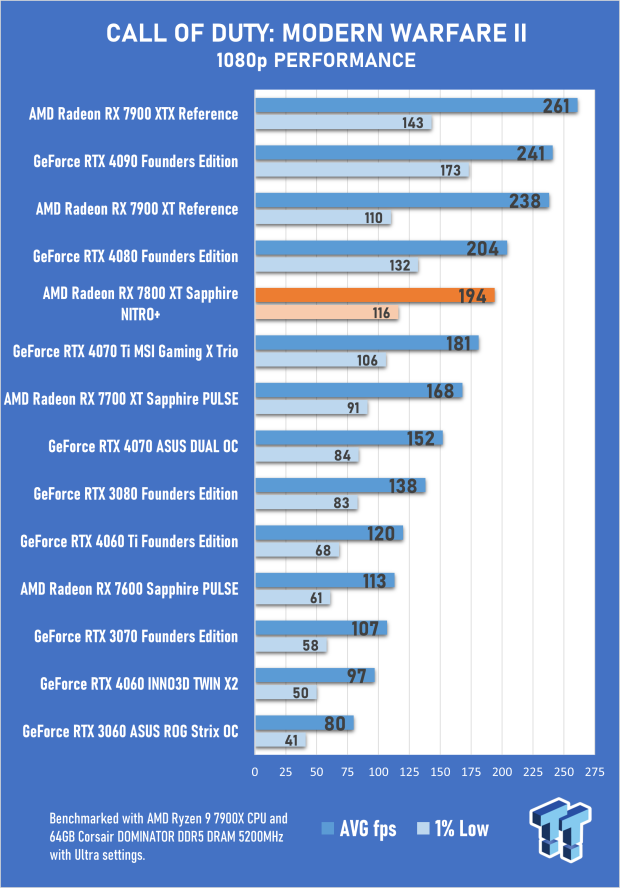
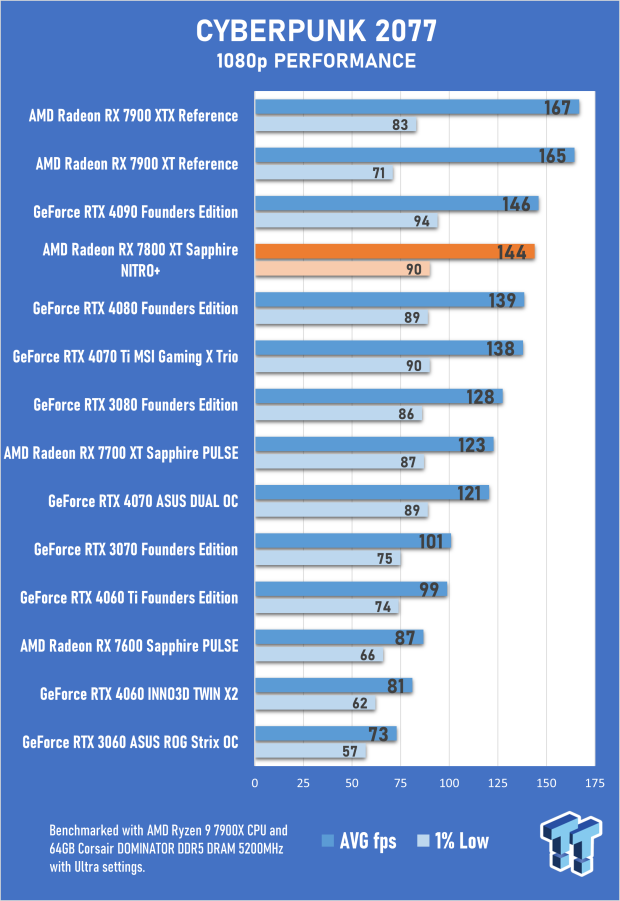
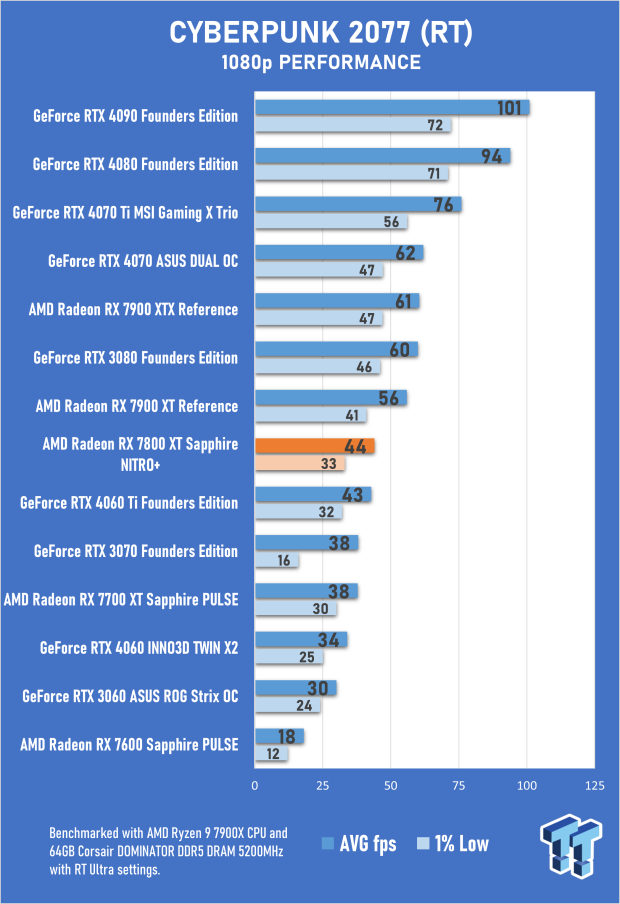
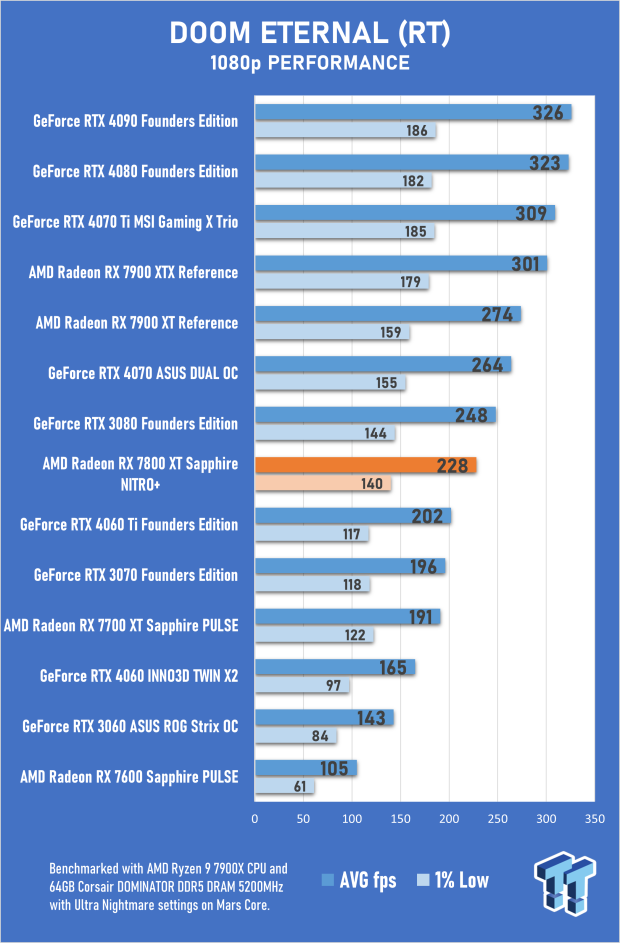
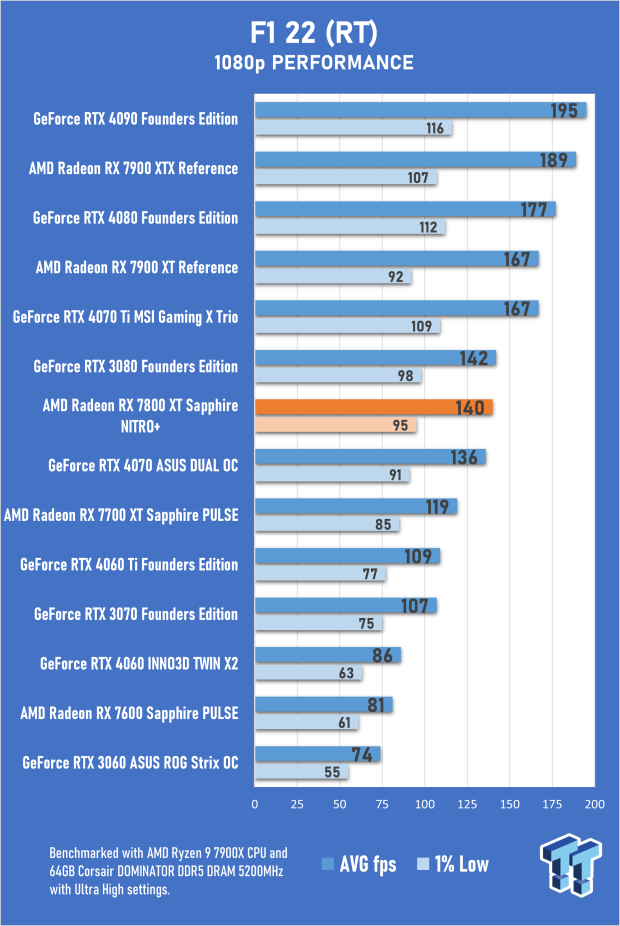
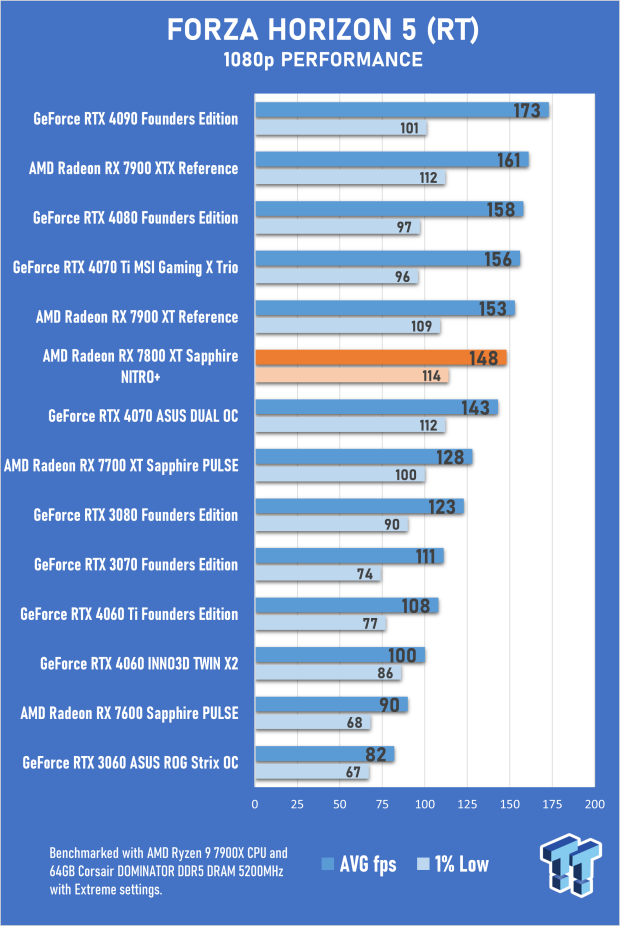
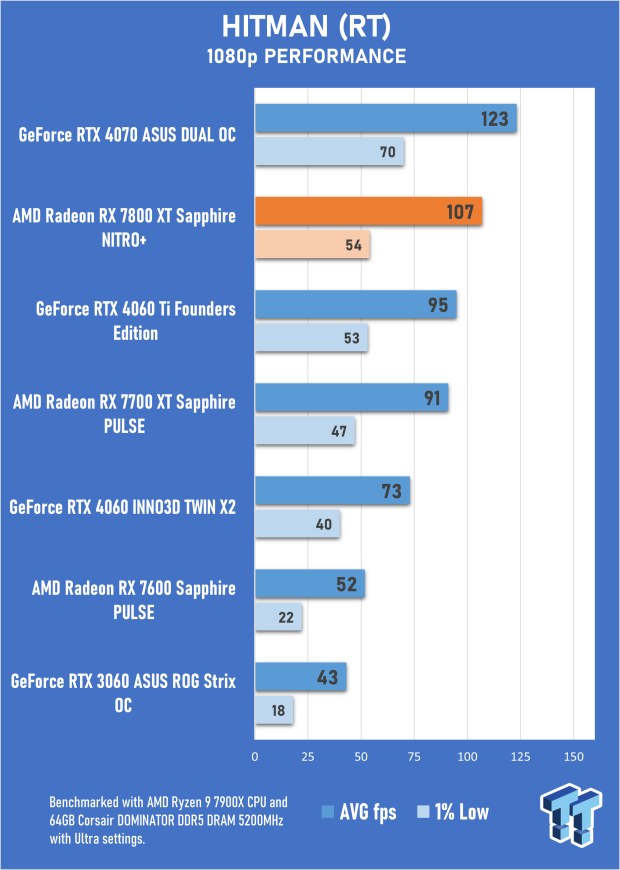
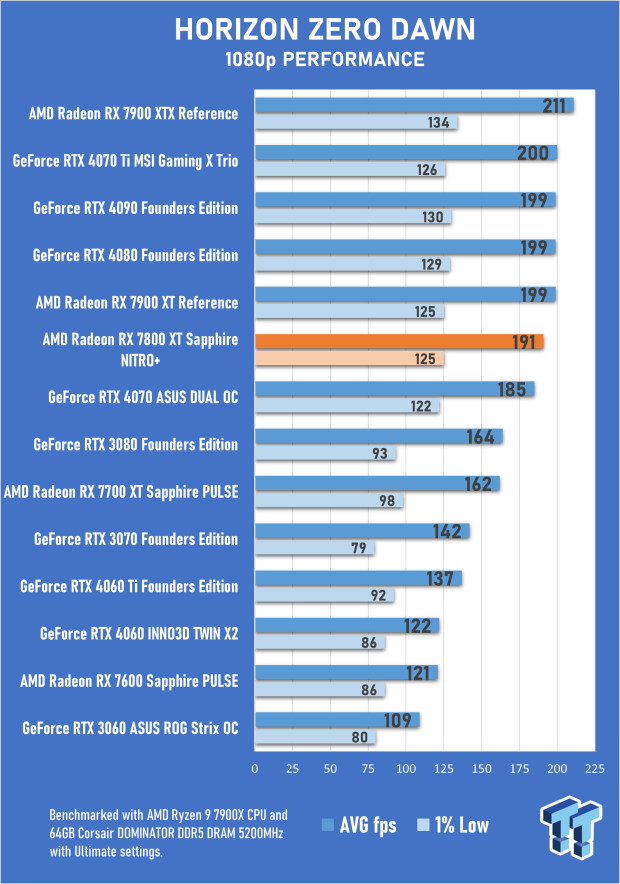
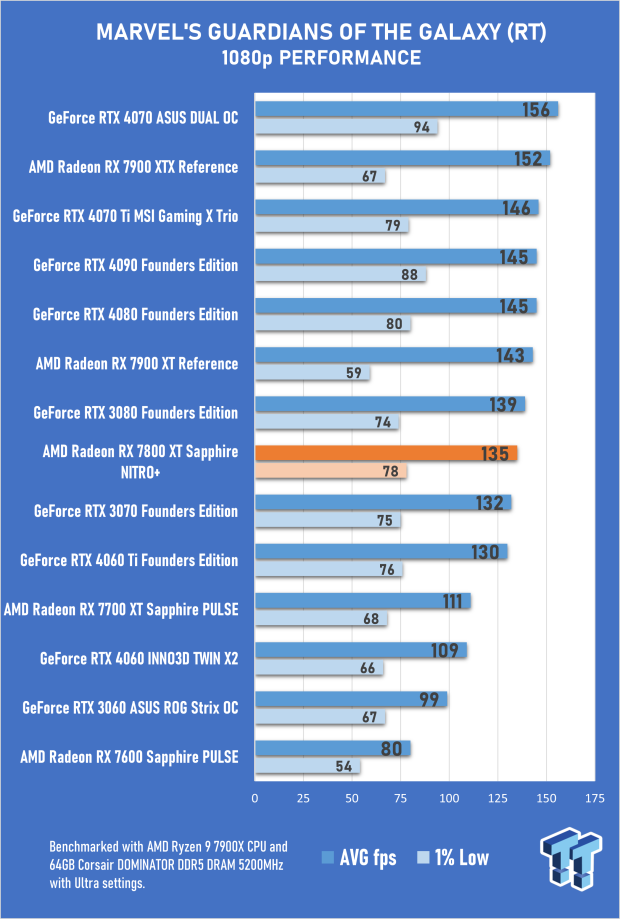
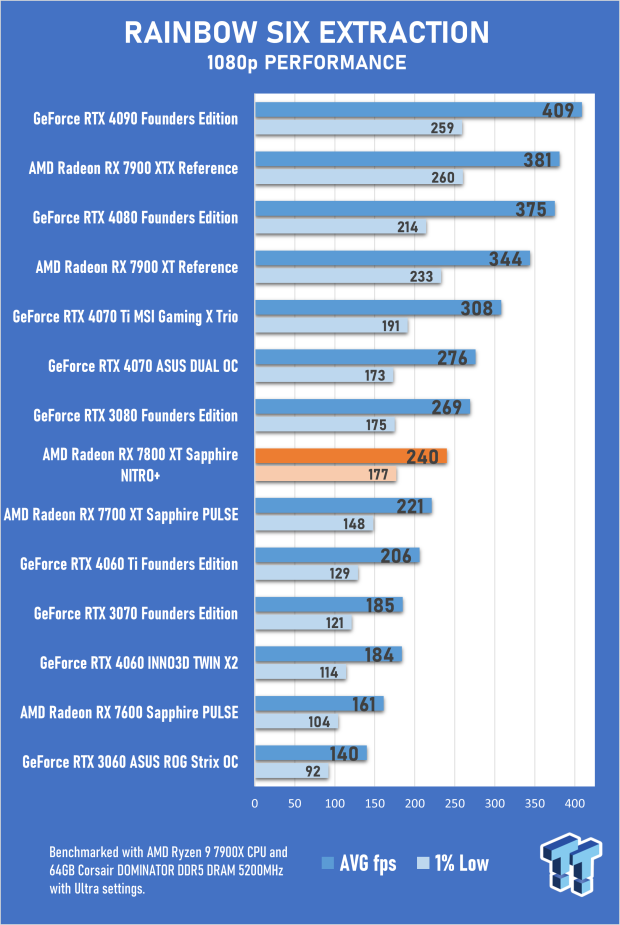
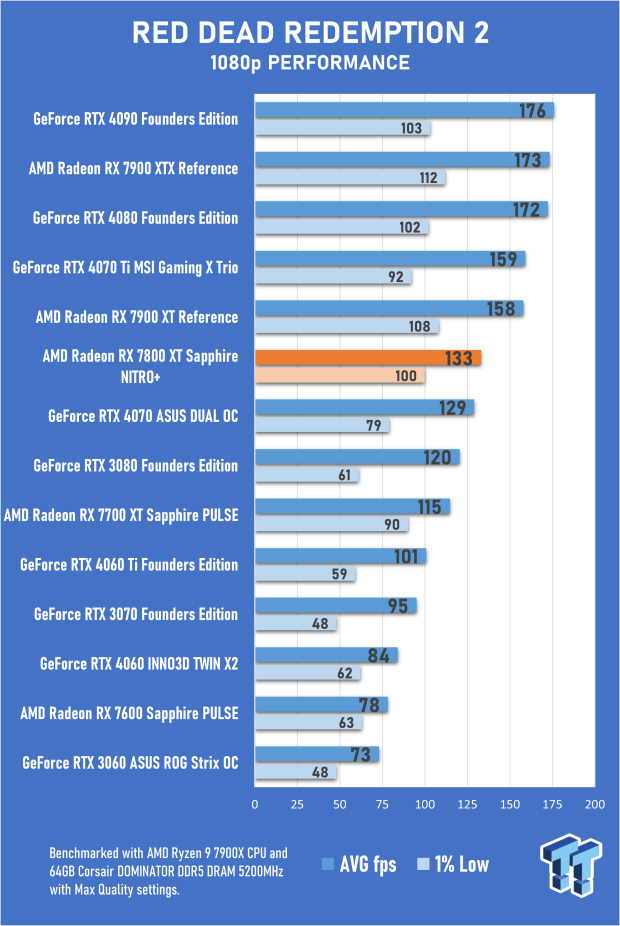
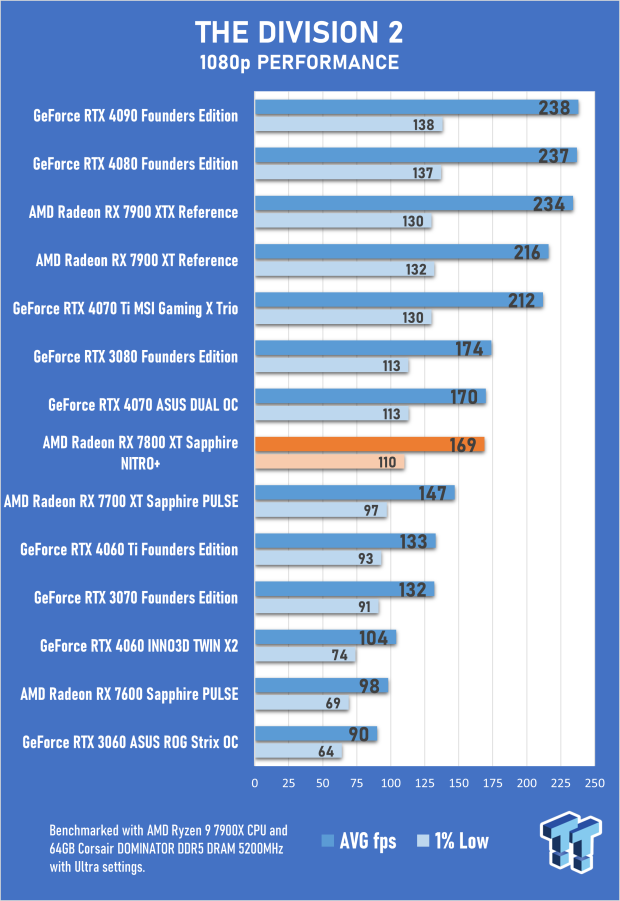
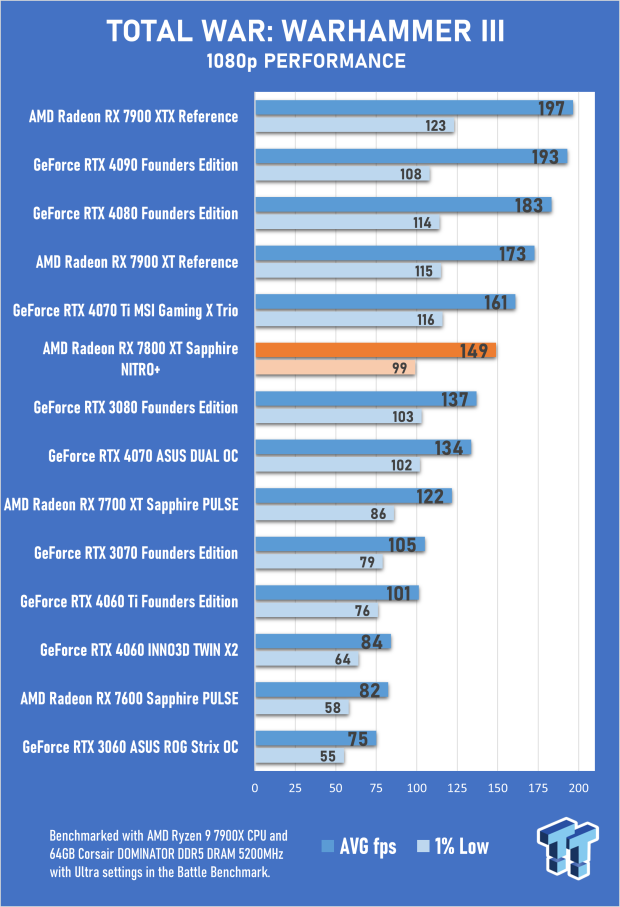
Benchmarks - 1440p Gaming
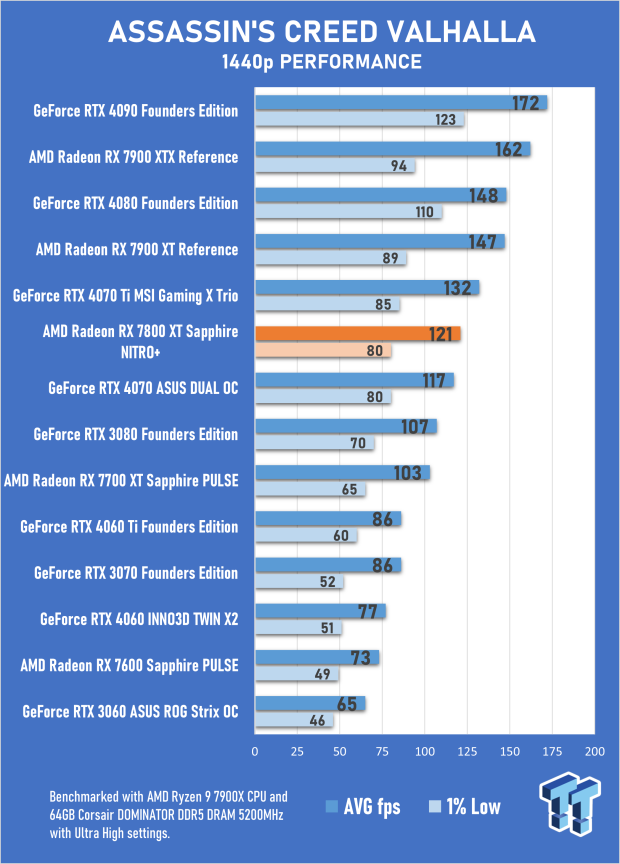
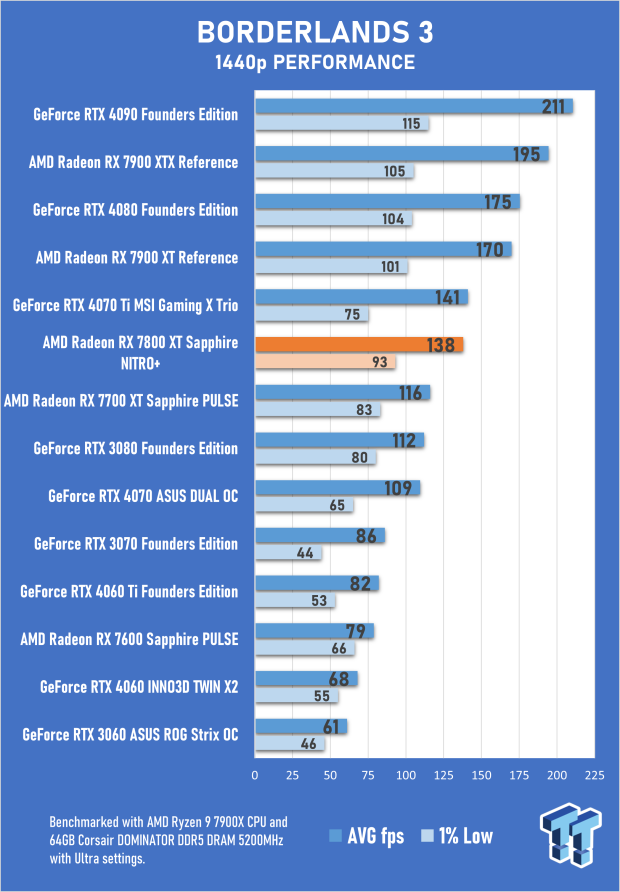
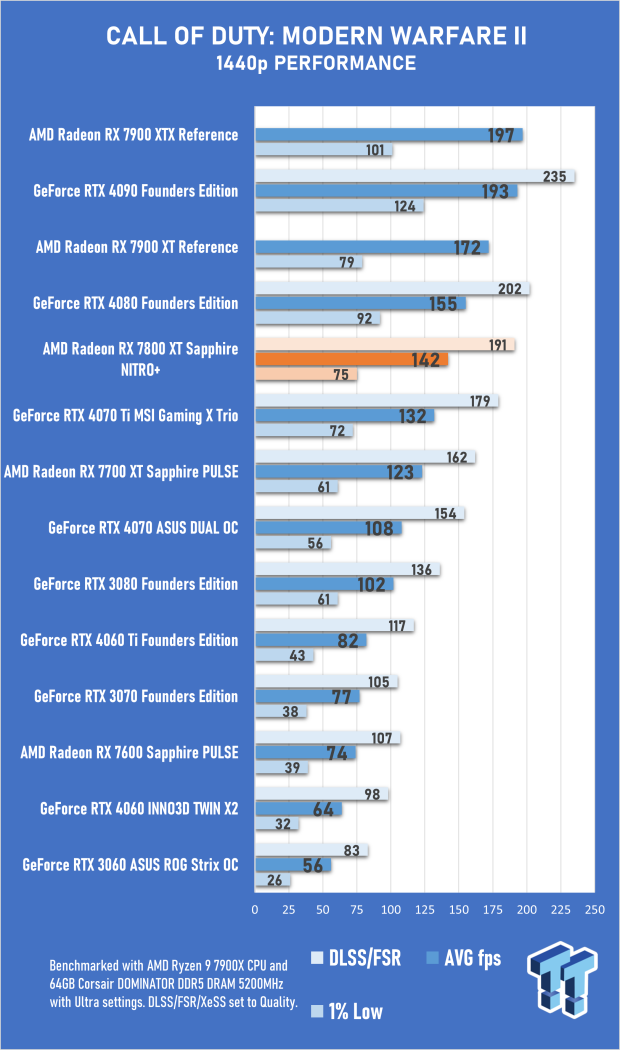
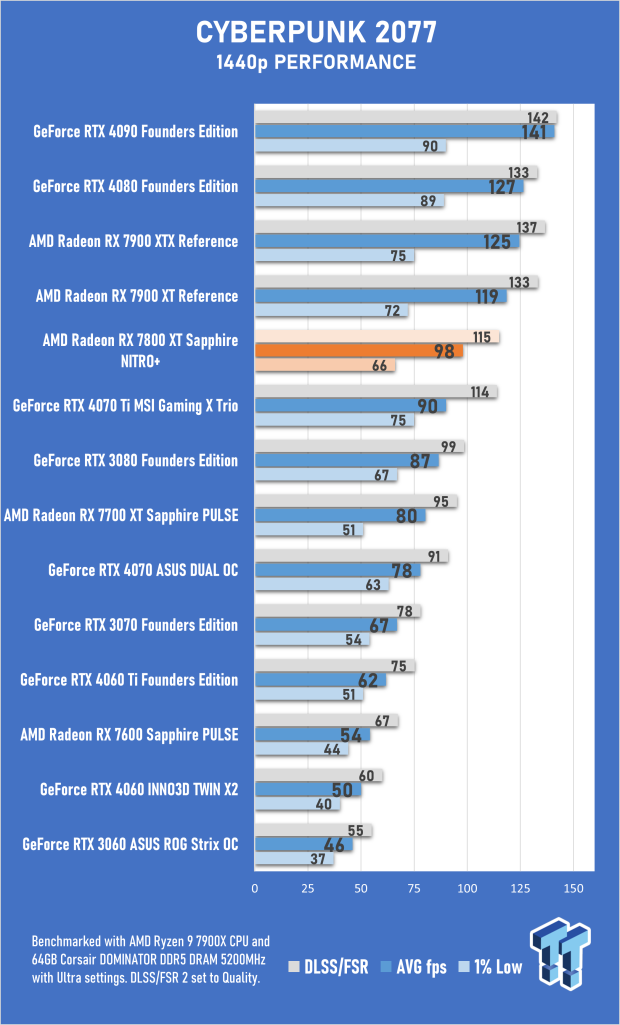
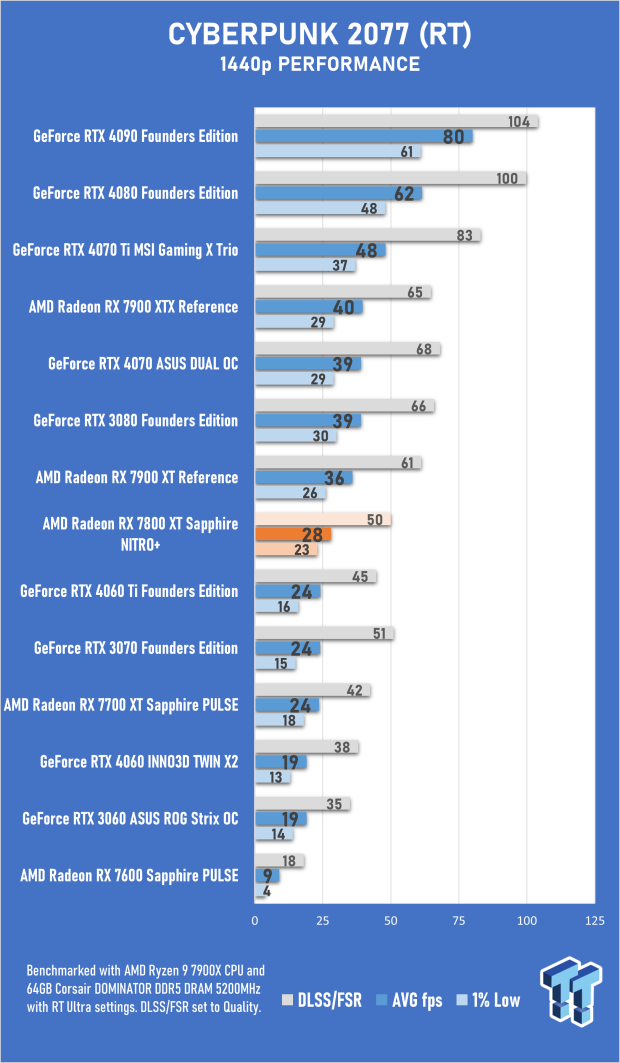
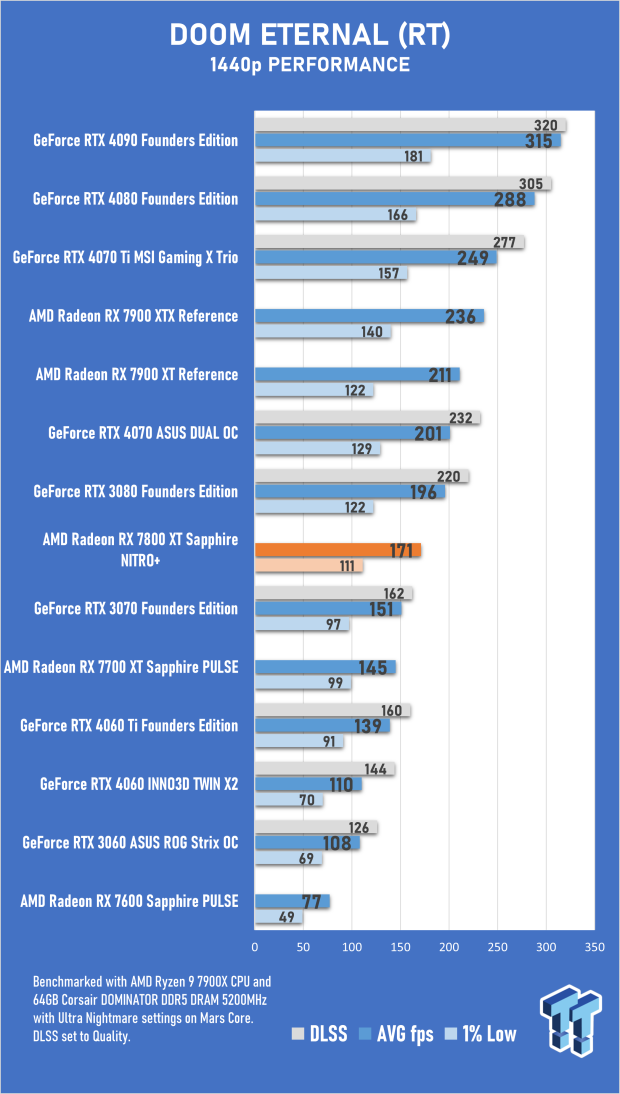
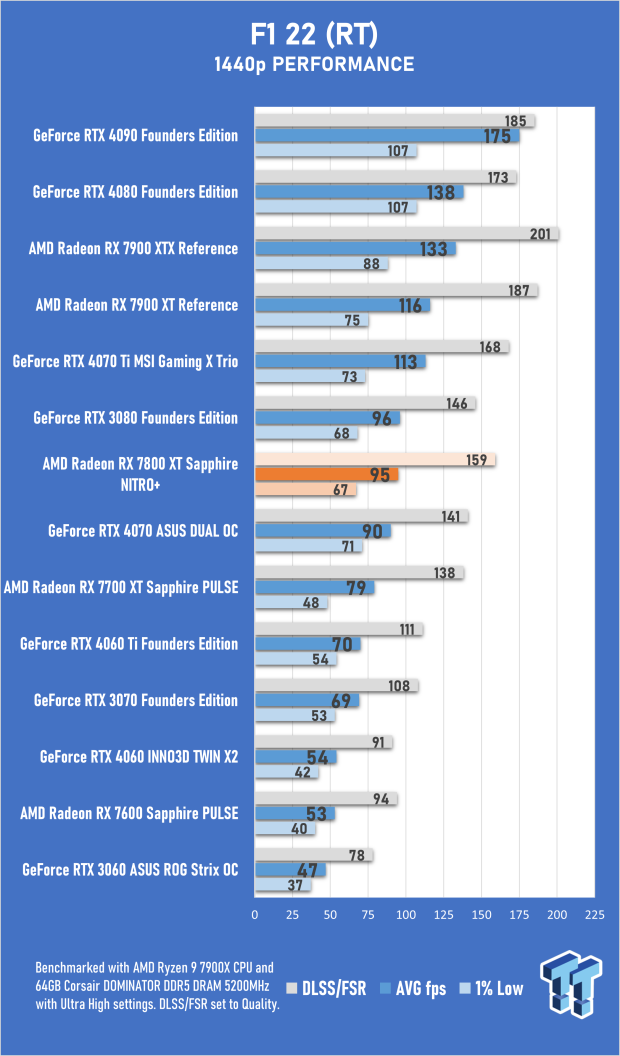
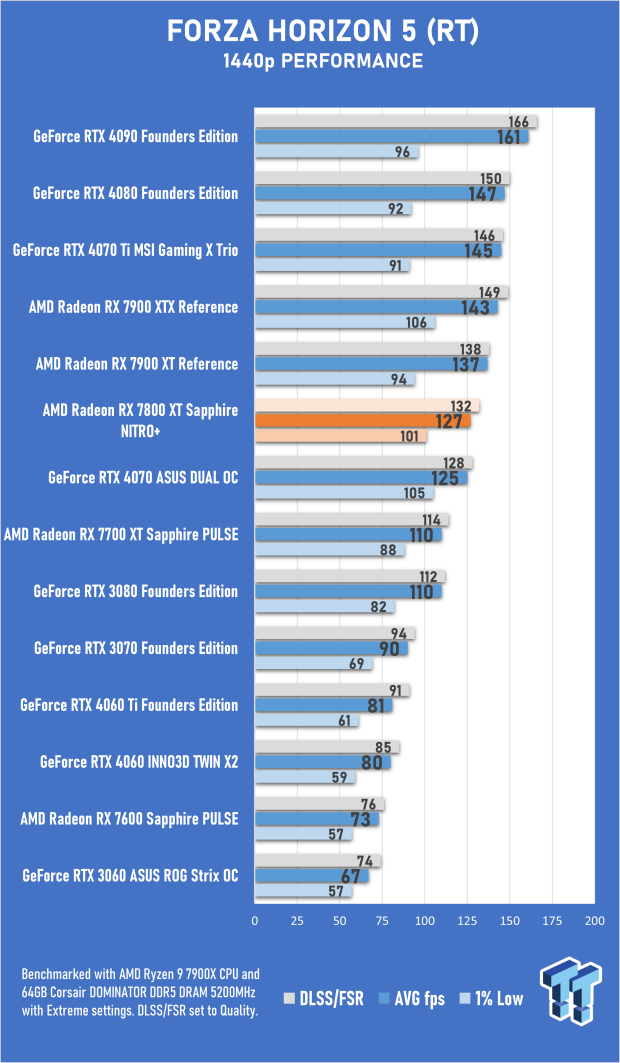
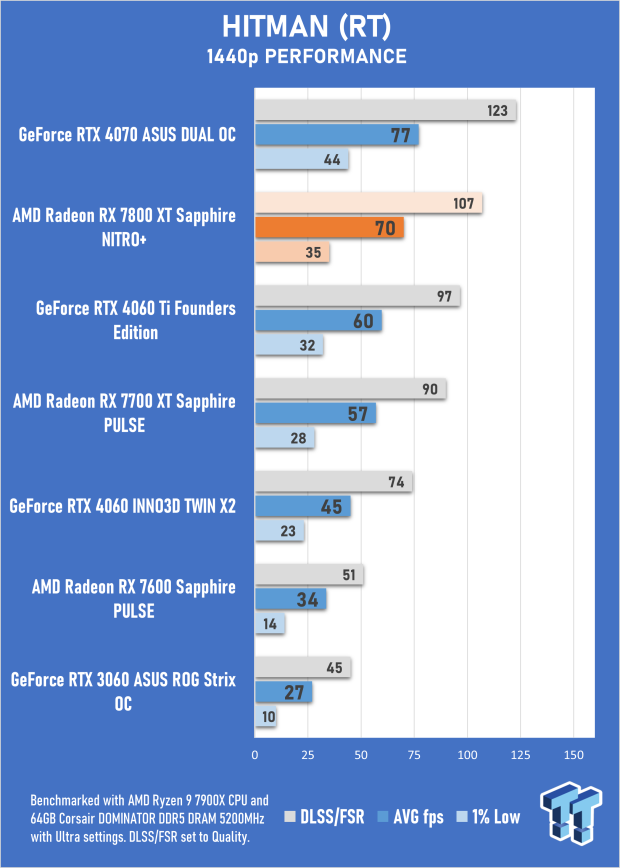
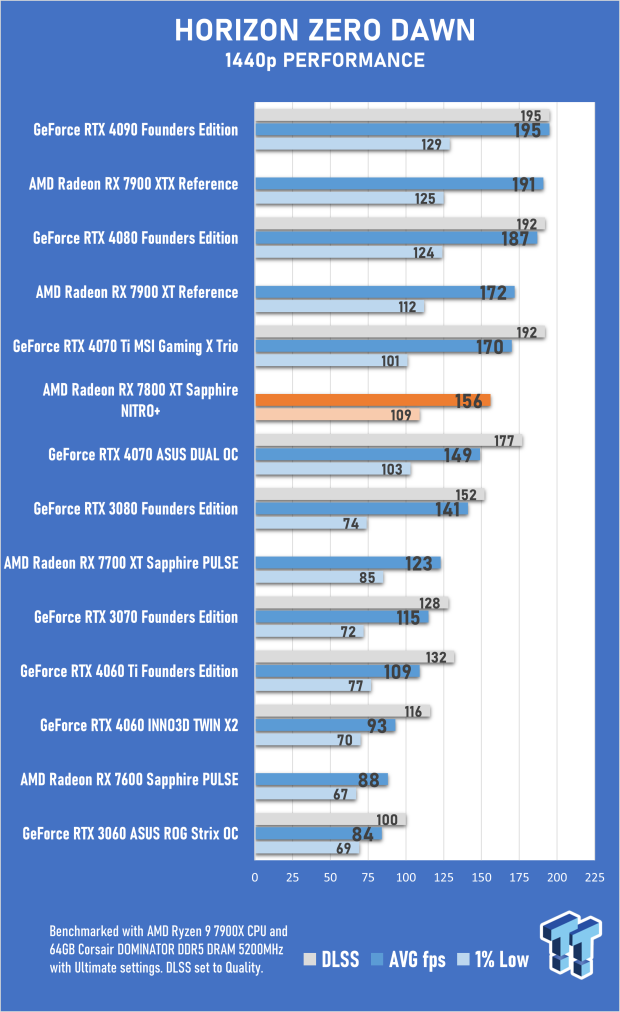
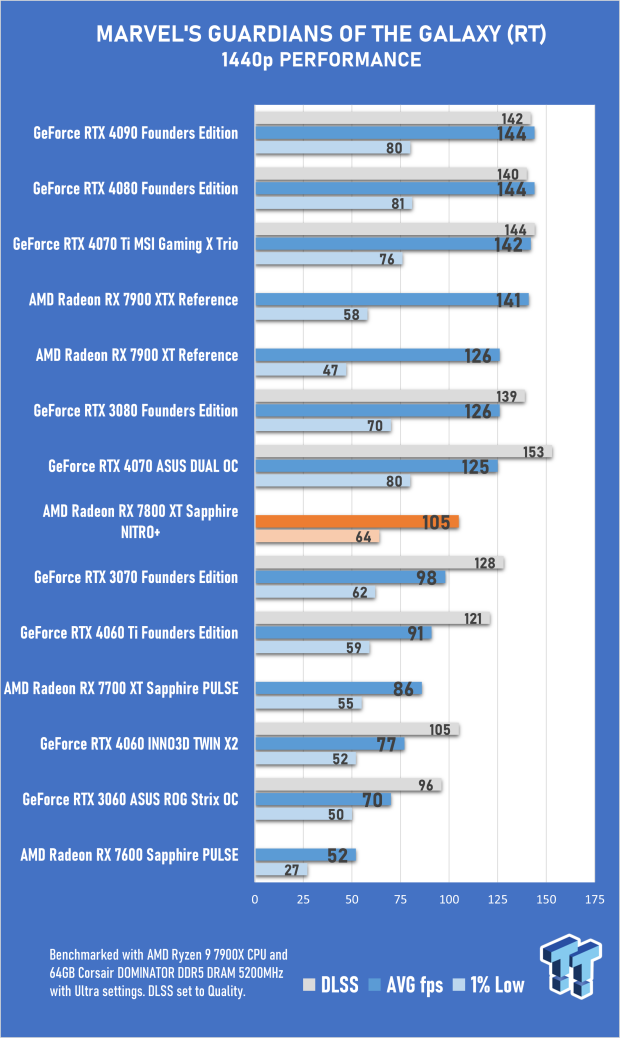
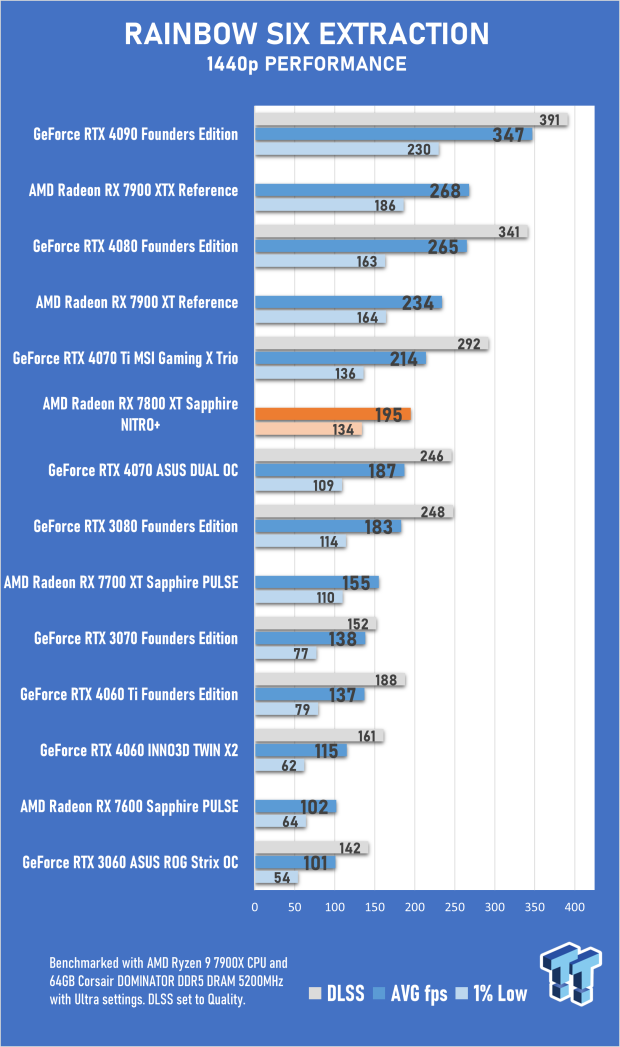
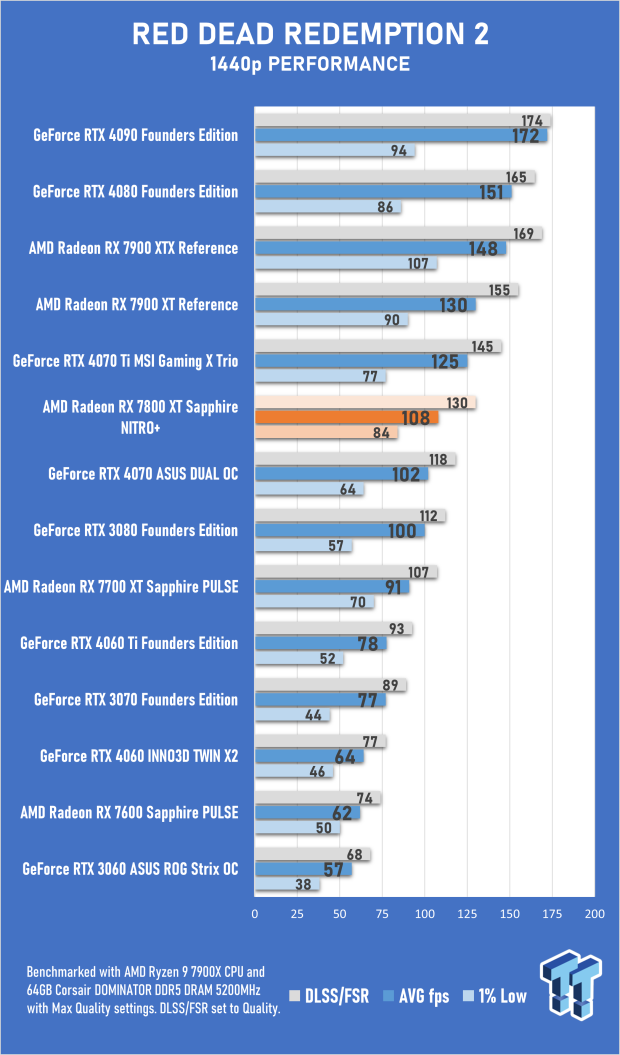
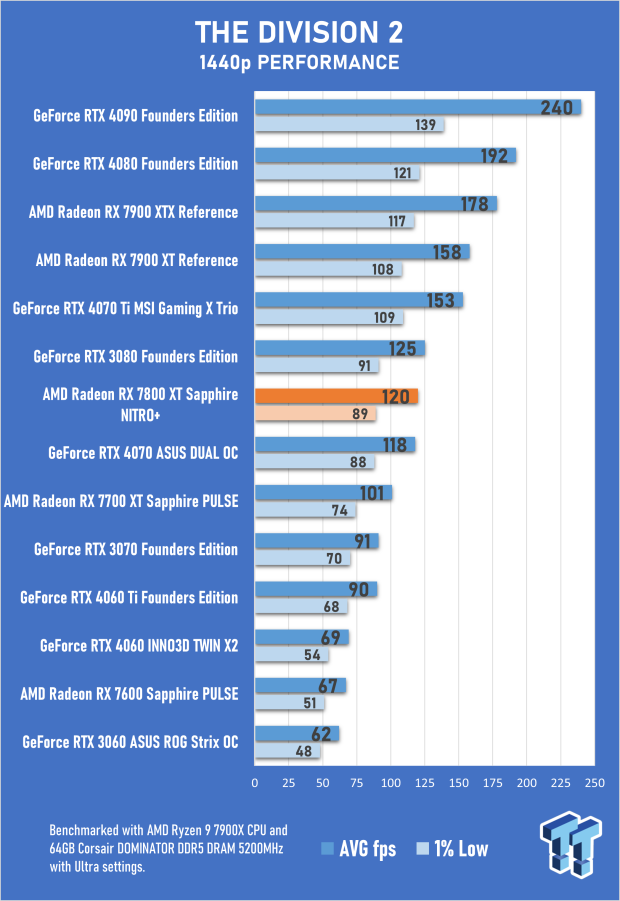
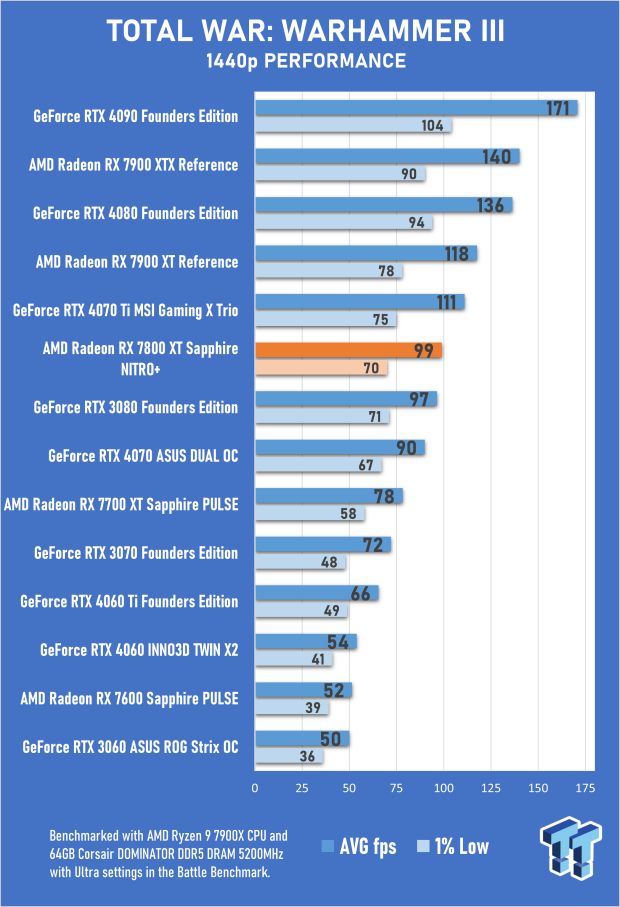
Benchmarks - 4K Gaming
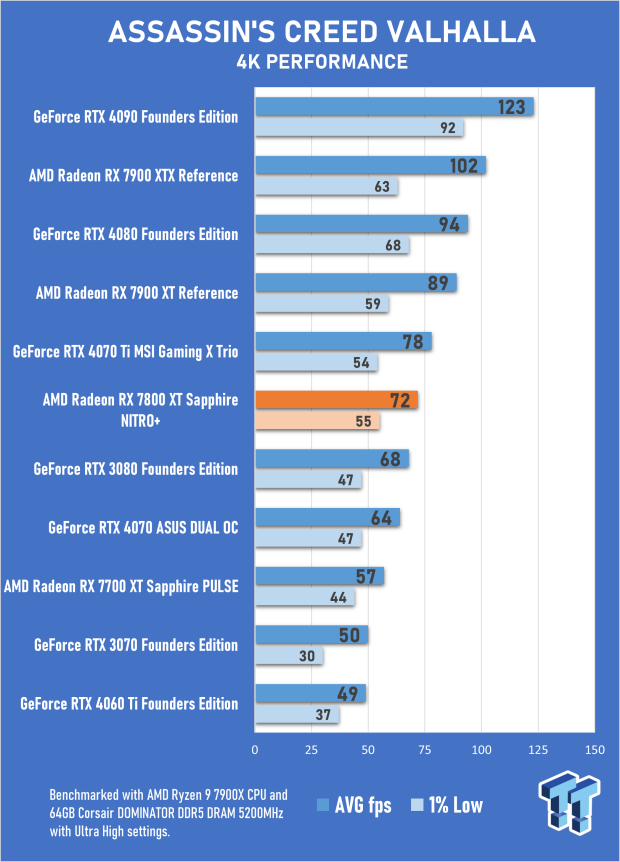

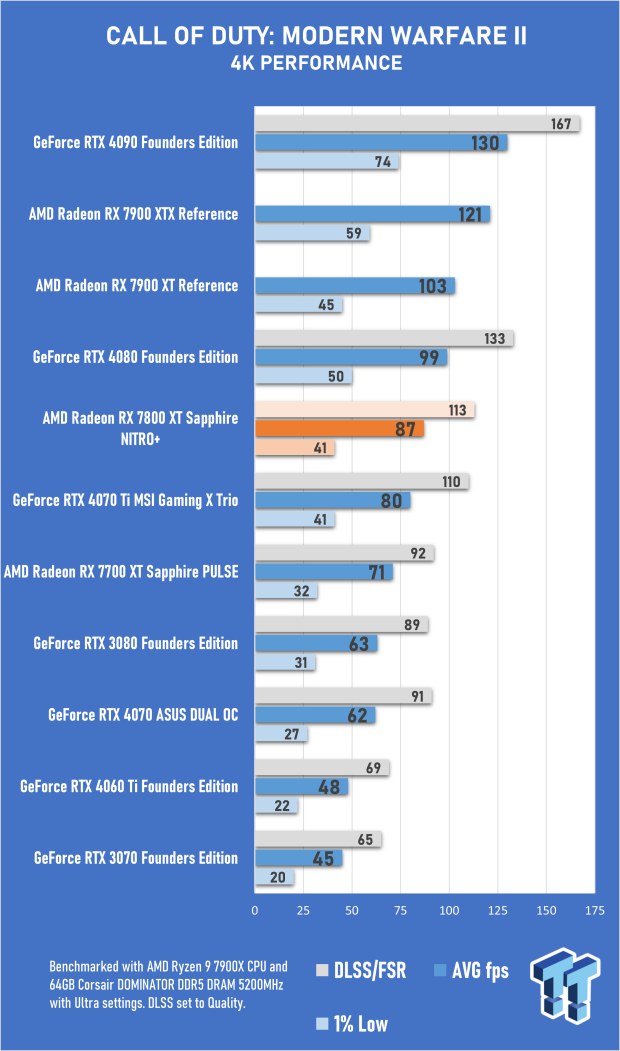
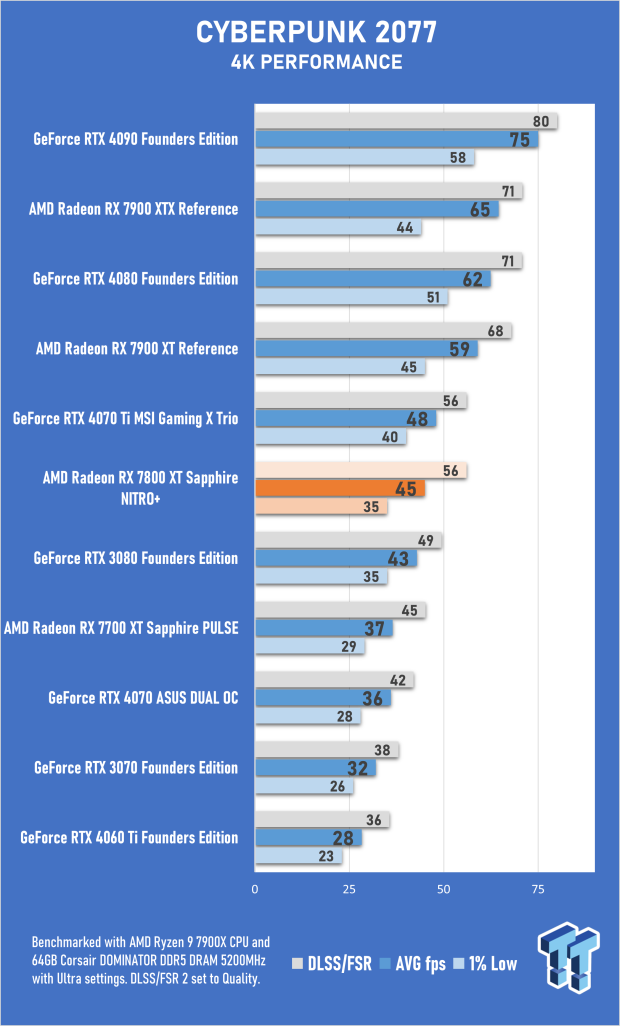
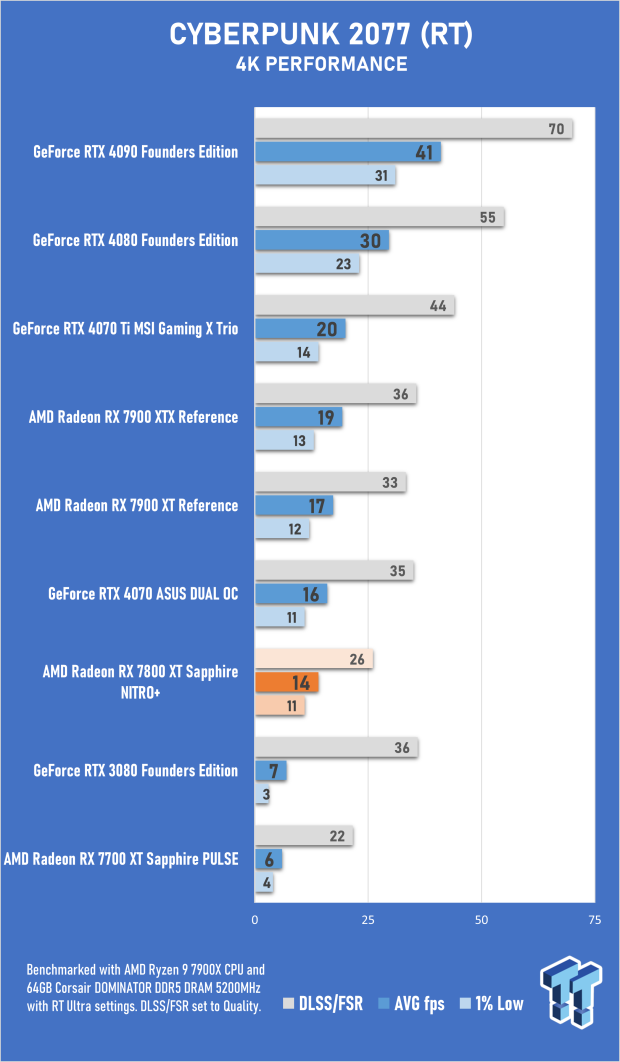
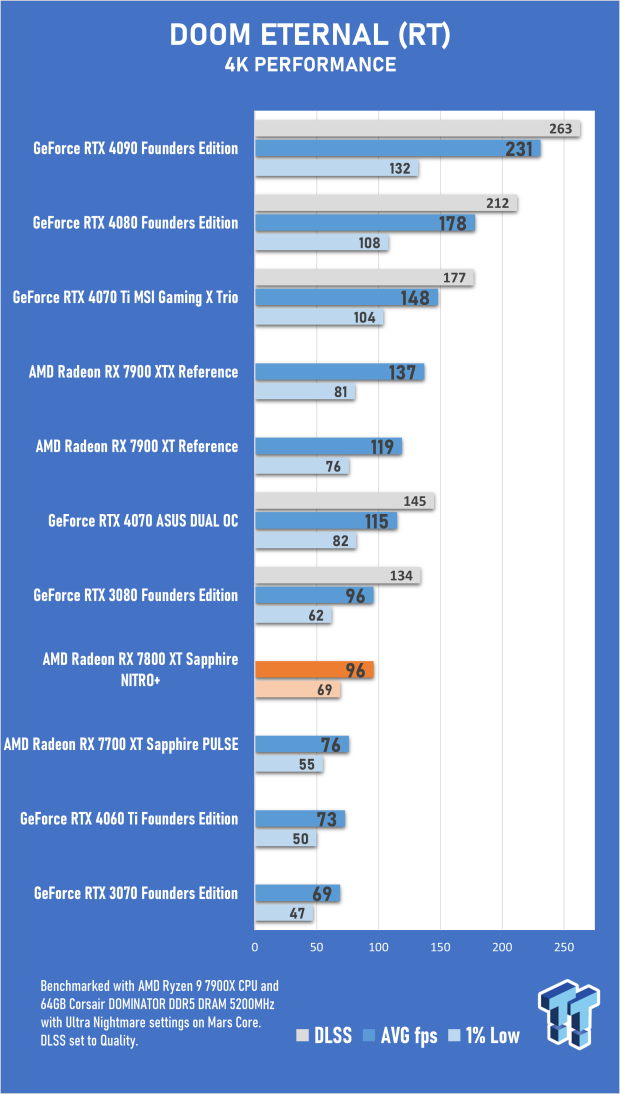
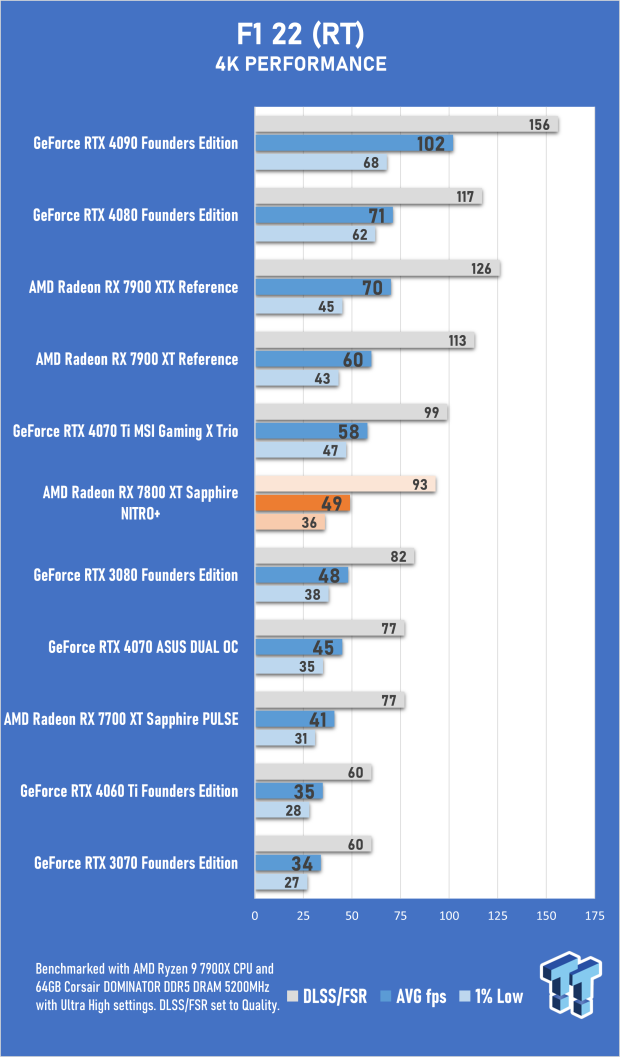
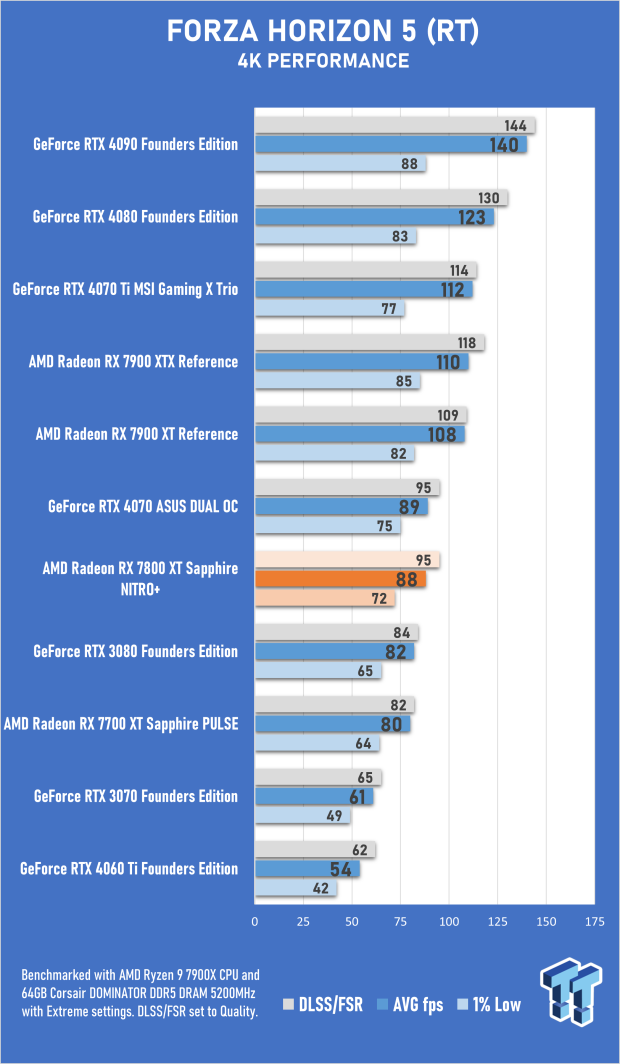
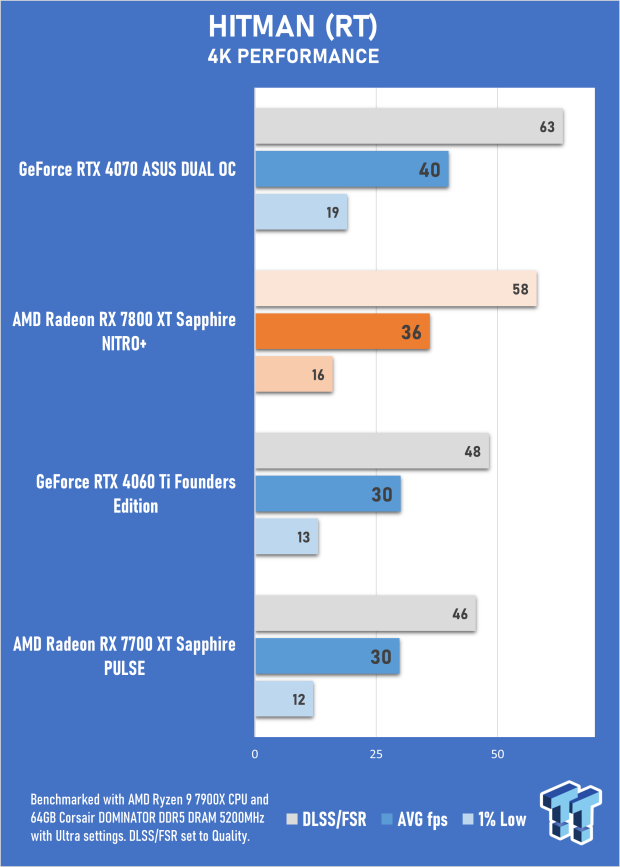
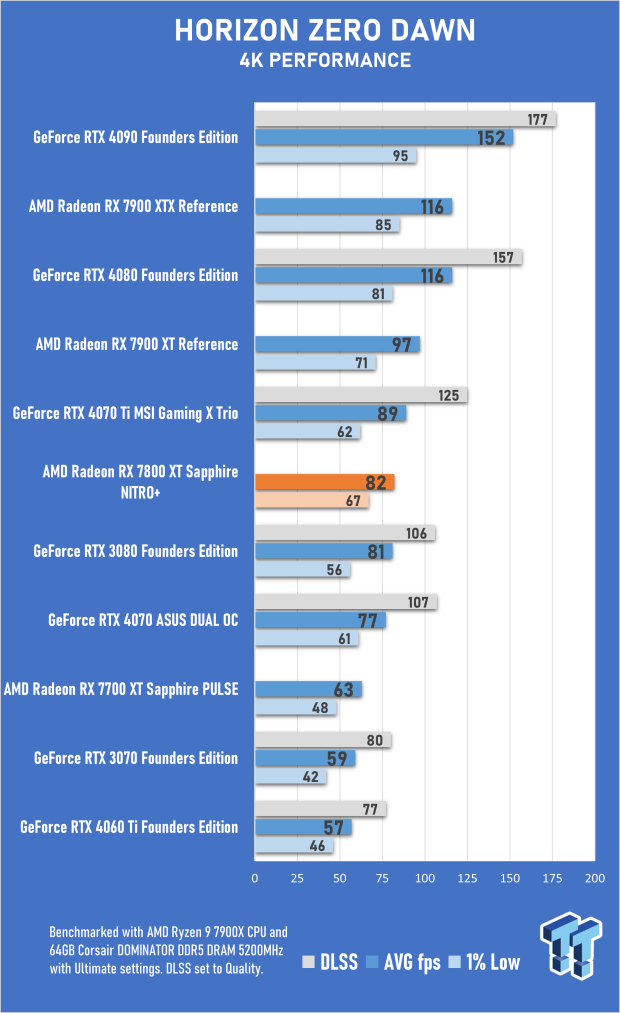
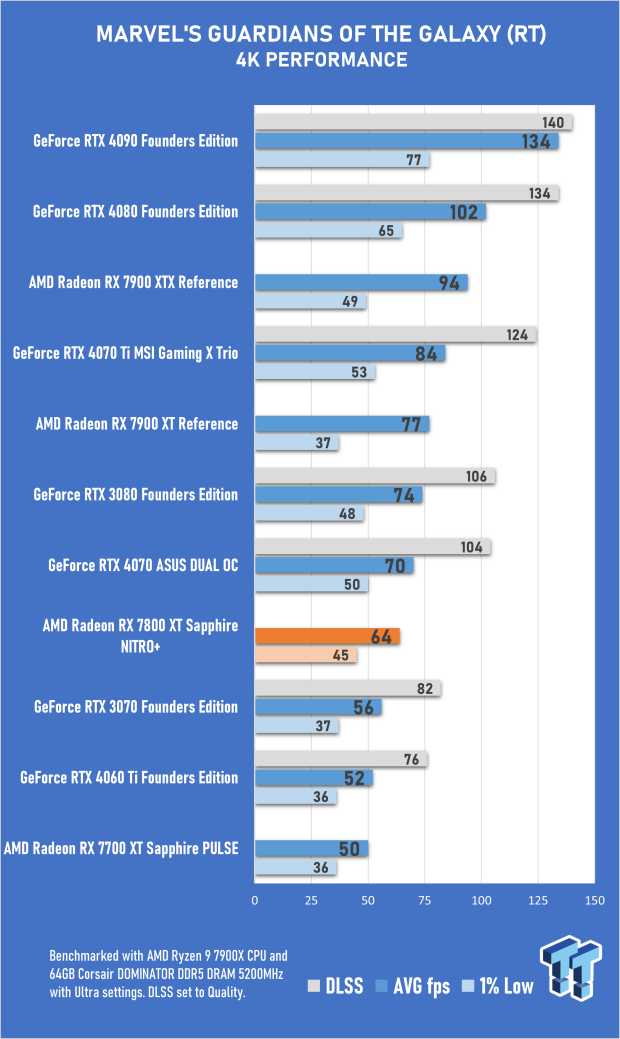
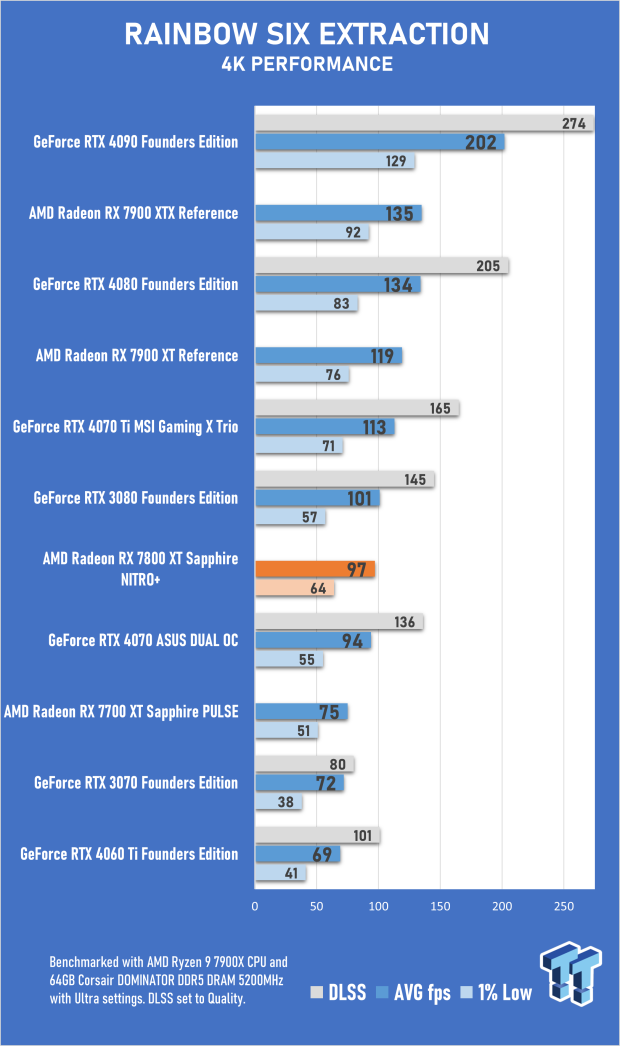
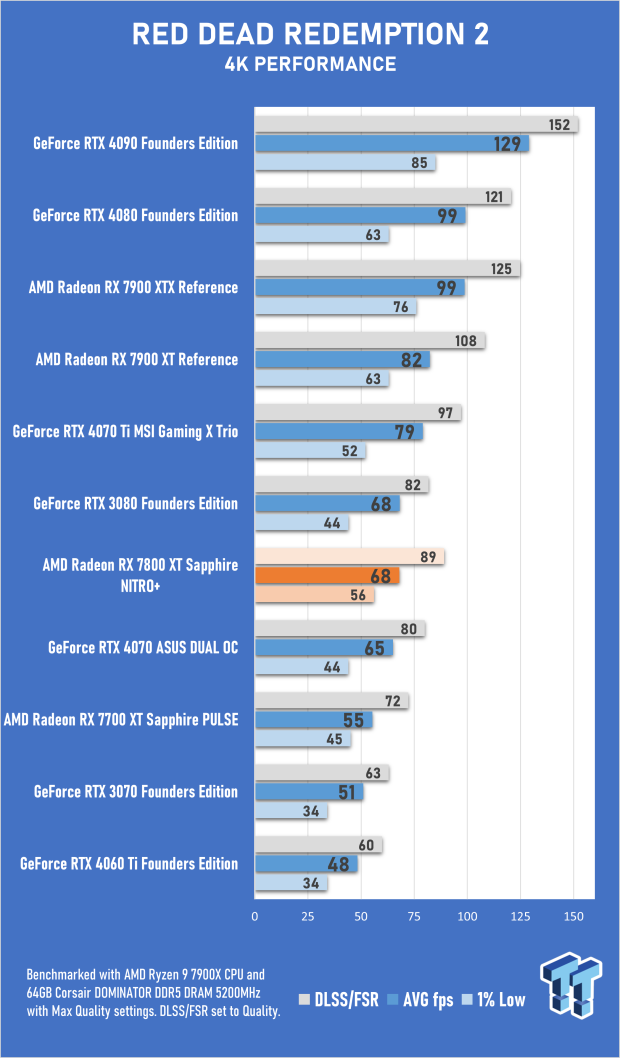
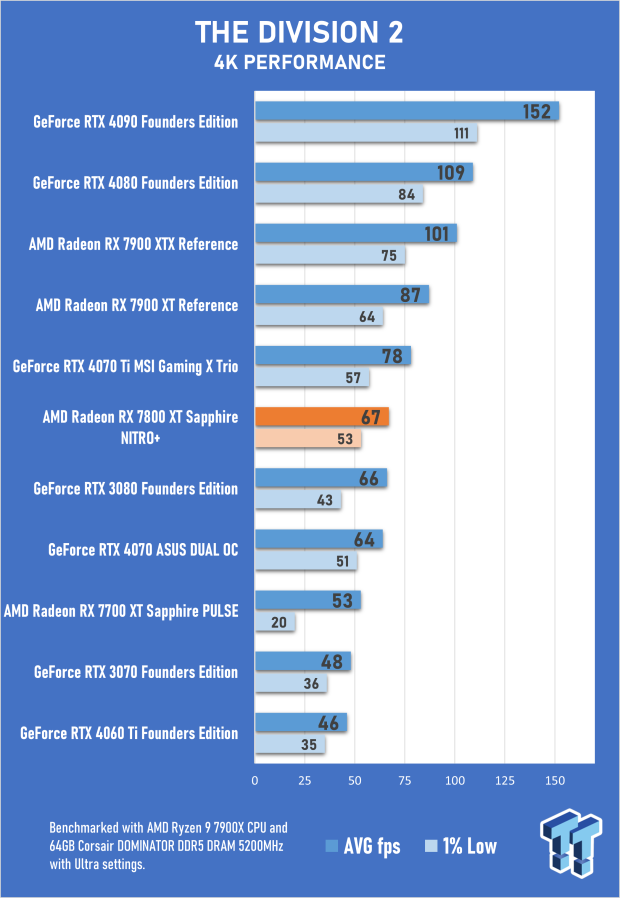
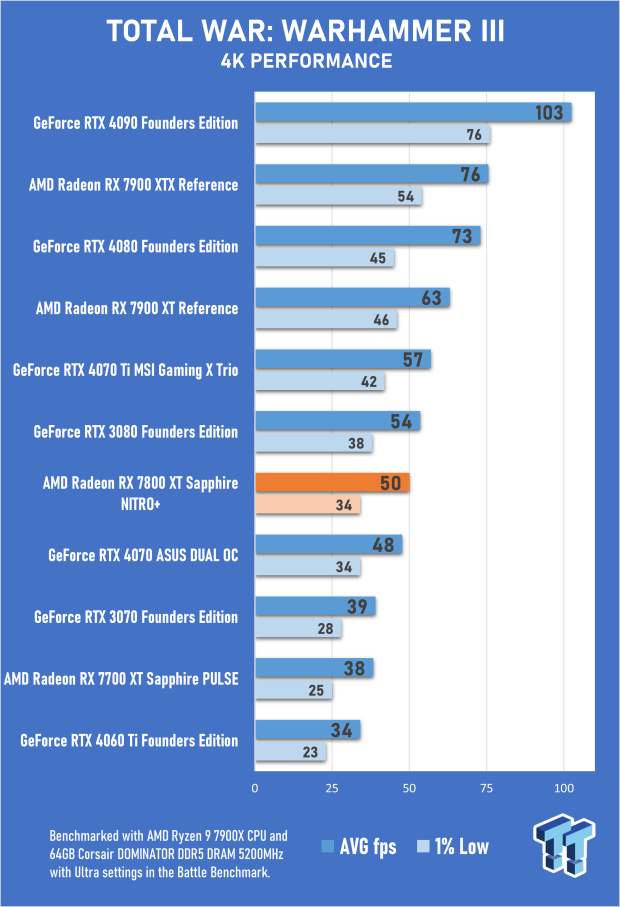
Benchmarks Summary - RT, FSR 2, and FSR 3
The Sapphire NITRO+ Radeon RX 7800 XT excels in 1440p gaming, where it outpaces the GeForce RTX 4070 outside of a few RT-heavy examples while featuring a lower price. This makes it an interesting successor to the Radeon RX 6800 XT - because you're not getting the sort of 30-40% performance uplift to make it feel like a generational uplift. It's a competitively priced graphics card that delivers on the promise of being able to run the most demanding games of 2023 while being more efficient (not by much, though) and affordable.
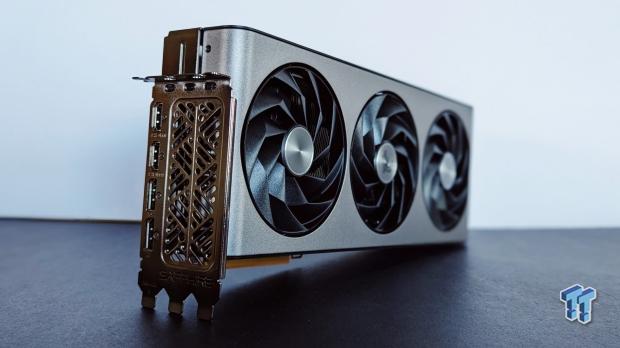
Unfortunately, even now (it's late September when I'm writing this), AMD's DLSS 3 Frame Generation answer is still not here. FSR 3 with AMD's open Fluid Motion Frames technology is yet to appear, so it's hard to gauge the added value of this feature (which will also work on GeForce GPUs) or compare it to DLSS 3. NVIDIA's AI-powered technologies are a selling point for the GeForce lineup, and even though the existing FSR 2 is available in many games, the performance comes at the cost of visual fidelity - more so and far more noticeable than DLSS at 1080p and 1440p.
However, the raw performance of the Sapphire NITRO+ Radeon RX 7800 XT is impressive, and the new Anti-Lag + low-latency technology for AMD's RDNA 3 GPUs has been released. It delivers a big improvement to competitive gaming and is the sort of tech that adds value to the Radeon lineup and the Radeon RX 7800 XT.
Temperature and Power Efficiency
Even though the Sapphire NITRO+ Radeon RX 7800 XT outperforms the GeForce RTX 4070 when it comes to 1440p gaming, it does so by using up to 50% more power than NVIDIA's card - which speaks to the incredible efficiency of the GeForce RTX 40 Series and the lackluster efficiency gains seen across the entire RDNA 3 generation. Power efficiency and overall usage is not a deal breaker for most people, nor does it factor into the buying decision, but it's worth highlighting.
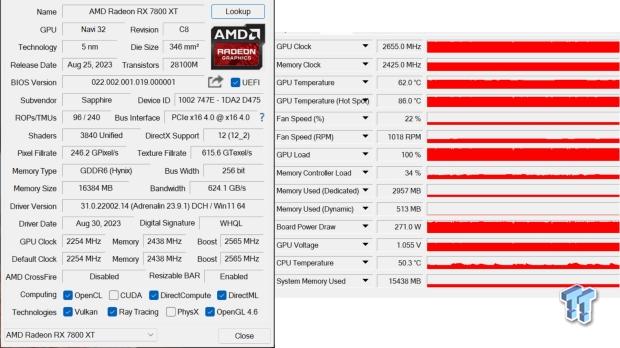
Under an extensive stress test, the GPU temperature of the Sapphire NITRO+ Radeon RX 7800 XT sat at around 62 degrees with a hot spot of 86 degrees - and with that, maintained a 22% 1000 RPM fan speed. Noticeably cooler and quieter than AMD's reference design, it's a testament to the physical and thermal design of Sapphire's premium NITRO+ model - while indicating that there's still room to overclock even higher with a more aggressive fan curve.
Final Thoughts and Starfield
With a lower price point than the competition, to help sweeten the deal, every Radeon RX 7800 XT also comes with a premium edition copy of Bethesda's latest RPG - Starfield. It is a game that is not only taxing on GPU hardware but CPU and storage too - so having something like the Sapphire NITRO+ Radeon RX 7800 XT means you can run the game with Ultra quality visual settings and maintain a great frame rate when playing in 1440p.
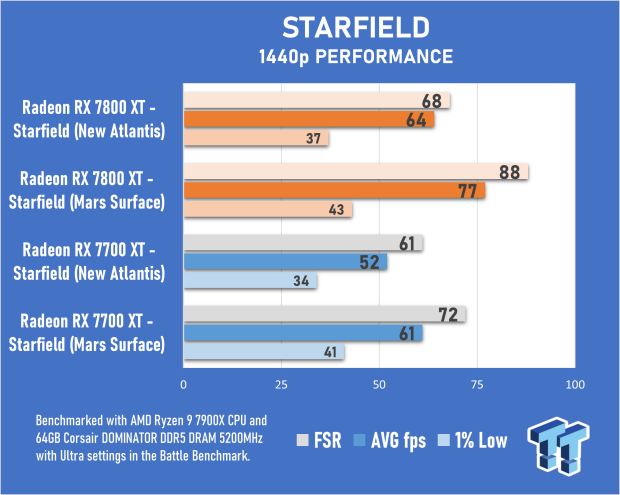
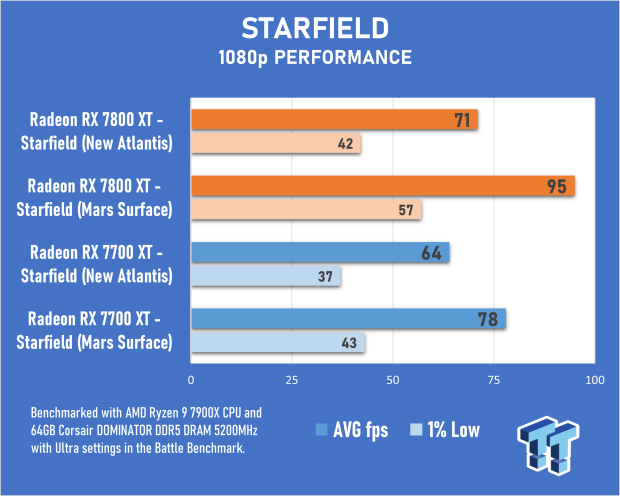
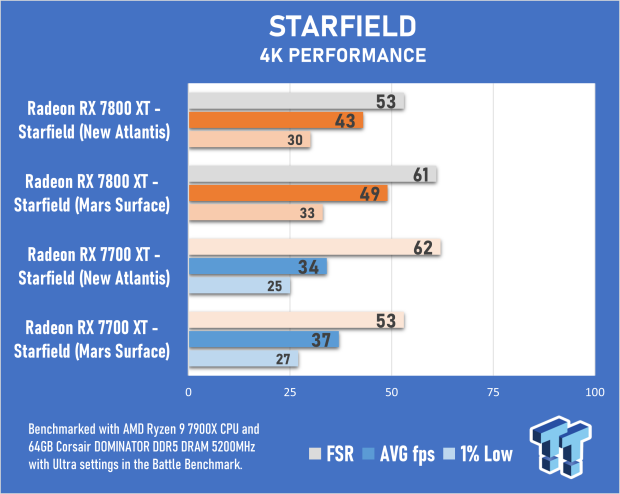
If you're interested in Starfield on PC and looking to make a GPU upgrade, the sort of add-on deal makes the price point for the Sapphire NITRO+ Radeon RX 7800 XT feel like a steal. Ultimately, that's what you're getting here - price and performance, all wrapped up in an elegant, minimal, and impressive physical build that is one of the best-looking and performing Radeon RX 7800 XT cards on the market.

